Wednesday, January 19: The breakfast buffet at Villa Langka is a still life, redolent with tropical fruits: melon, papaya, bananas, mango, pineapple, passionfruit, dragon fruit.

breakfast at the villa langka ~ I love this place:-)
My plate is so artfully arranged, I don’t want to disturb it. I linger, sitting by the poolside surrounded by tropical abundance, savoring these jewel-fruits, these bursts of mellow sweetness. A perfect start to my day.
Mr. Lo is waiting for me with his tuk tuk. We start off by heading to Tuol Sleng Genocide Museum, the former high school turned prison and interrogation center in Phnom Penh, Cambodia’s capital. It served as Security Prison 21 (S-21) for the communist Khmer Rouge regime from 1975-1979, the years when they were in power. The regime converted the buildings by enclosing them in electrified barbed wire. The classrooms became tiny prison and torture chambers and windows were covered with iron bars and barbed wire to prevent escapes.

mr. lo and me in his tuk tuk
I walk around the former prison, which has been kept in the state it was when the regime fell in 1979, except cleaned up. It’s haunting. I first walk through the larger rooms where people were strapped to beds, tortured and interrogated. Nearly every room contains one metal-framed bed, a few torture instruments and a black and white photograph of someone being horribly tortured. When prisoners were brought here, they were stripped, and all their possessions taken. Then they made confessions of all their activities from the moment they were born until they were arrested, which were transcribed by the prison officials. Often these confessions would be thousands of words and would interweave truth with fictions of spying for the CIA or Vietnam (probably obtained under torture).
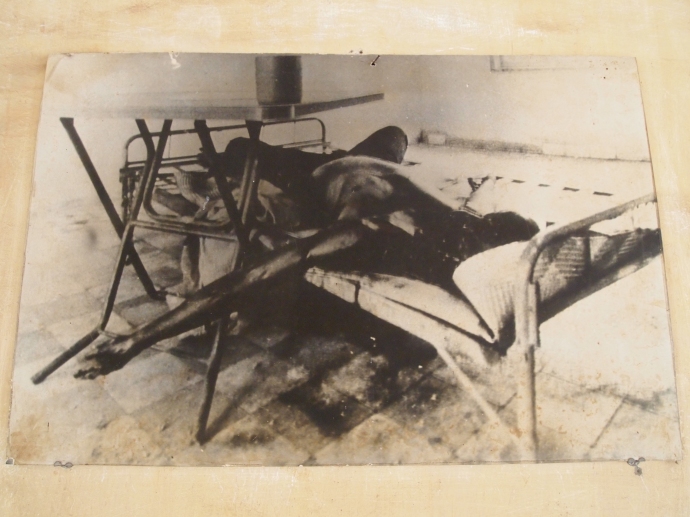
a horrifying picture of torture
Men, women and children alike were tortured by horrible means: beaten and tortured with electric shocks, searing hot metal instruments and hanging. Some prisoners were cut with knives or suffocated with plastic bags. Other horrible means of torture were used as well, including waterboarding and pulling out fingernails while pouring alcohol over the wounds. Often the confessions obtained through such tortures included the names of hundreds of the prisoner’s friends, family or acquaintances who were guilty of some crime against the Khmer Rouge.
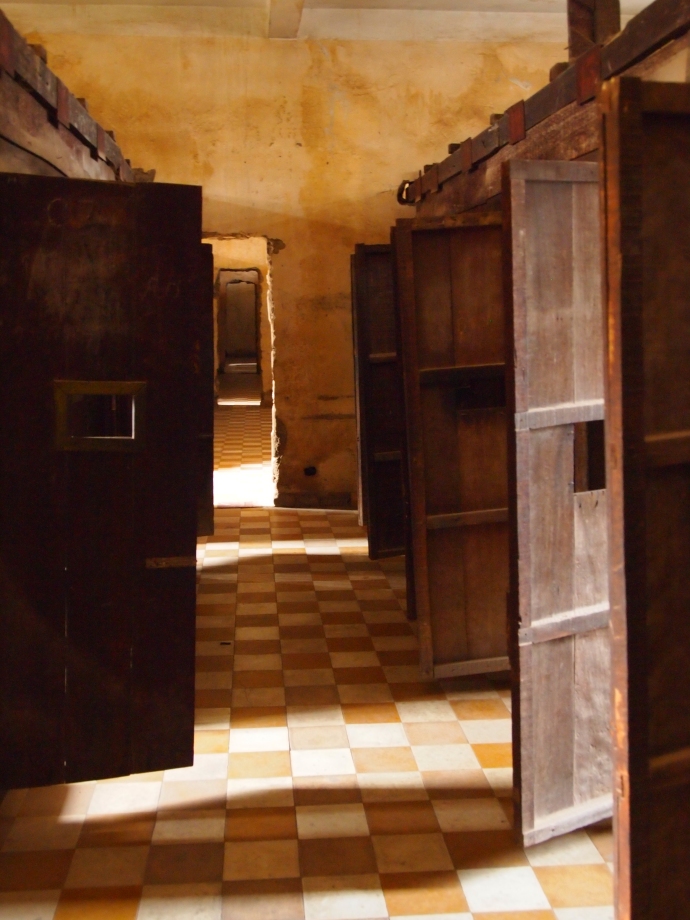
rows of tiny cells in the prison
It’s such an incredibly distressing place. So dark, you can almost feel the evil that once lurked here. After the torture rooms, I go to another building where there are rows and rows of tiny rectangular cells, the size of long skinny closets, where prisoners were shackled to the tiled floor. In other rooms, there are giant boards of black and white photos of young and old, male and female, Cambodians staring desperately at the camera. It’s deathly quiet in the museum. Deathly.
The Khmer Rouge apparently kept detailed records of every prisoner, every confession, every action they took. All this is on display at the museum.
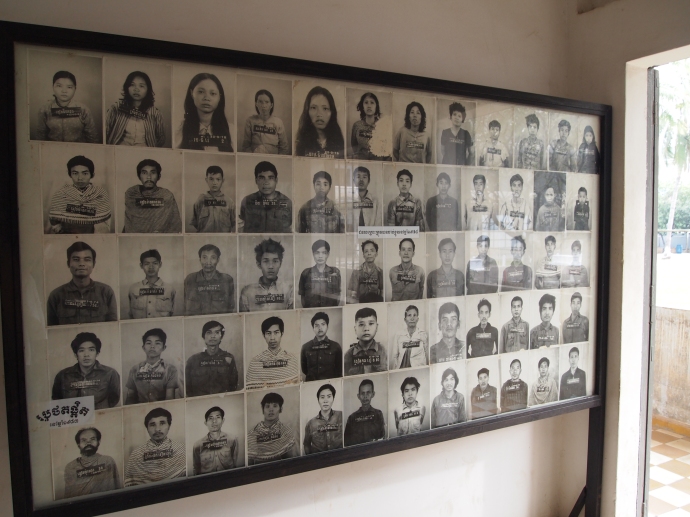
faces of victims
It’s estimated that anywhere from 17,000-20,000 prisoners were held here during the Khmer Rouge reign, with 1,000-1,500 at any one time. Prisoners initially included people from the previous Lon Nol regime: soldiers, government officials, as well as academics, doctors, teachers, students, factory workers, monks, engineers, etc. Later, the Khmer Rouge paranoia extended the killing to those within their own ranks. Most prisoners stayed for 2-3 months, after which time they were killed and buried near the prison. When space eventually ran out, the regime transported prisoners to the Killing Fields of Choeung Ek.
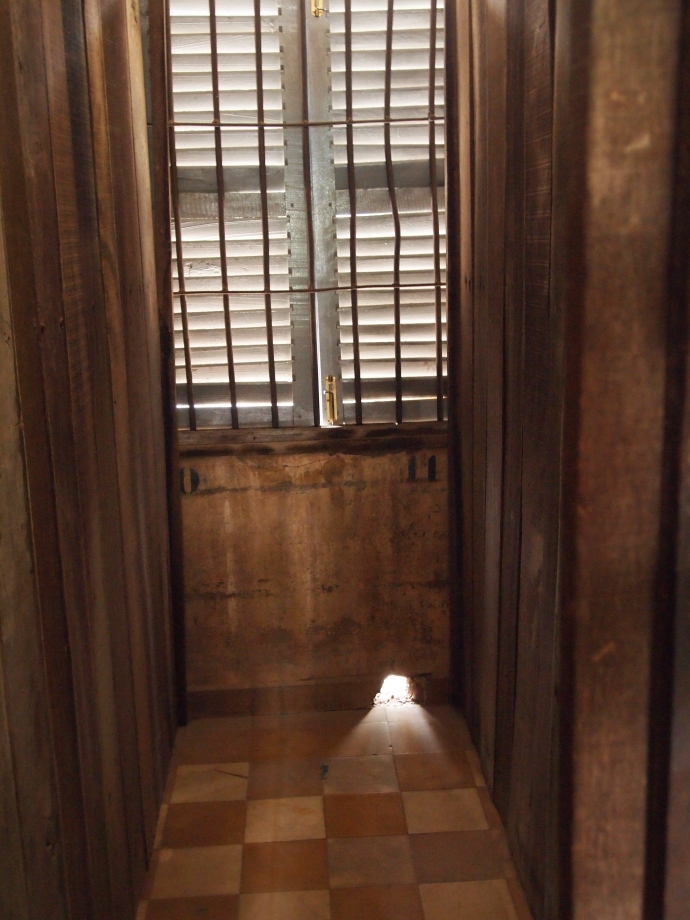
one of the tiny closet-like cells
When I leave this horrible prison, Mr. Lo drives me in his tuk tuk to Choeung Ek, about 15 km outside of Phnom Penh. I follow in the footsteps of around 18,000 people who were transported from Tuol Sleng to The Killing Fields and brutally murdered.
It’s a slow drive in a tuk tuk to the Killing Fields. I am all eyes and ears as we ride along, motorbikes buzzing all around. Again, as in Vietnam, we pass businesses of every sort imaginable operating out of concrete cubbyholes with rusty corrugated metal roofs. In store fronts, there are racks of old-fashioned and dirty Pepsi bottles filled with a yellow-green liquid. I can’t help but wonder what is that liquid the color of urine in those dirty bottles. Later, I find out they contain gasoline for motorbikes.
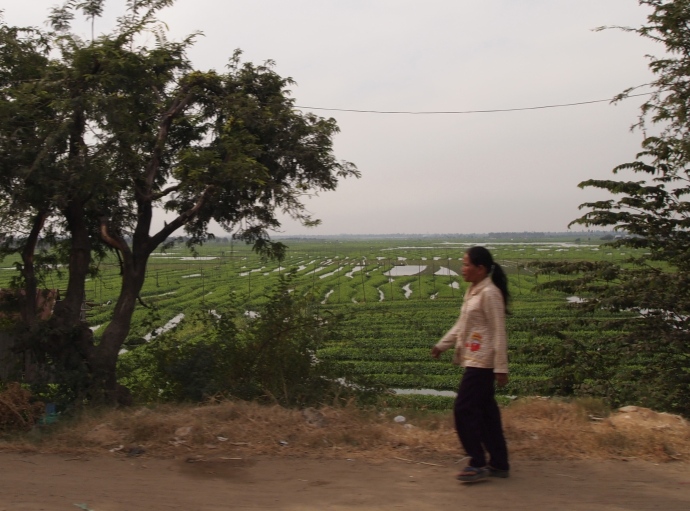
street scene on the way to the Killing Fields
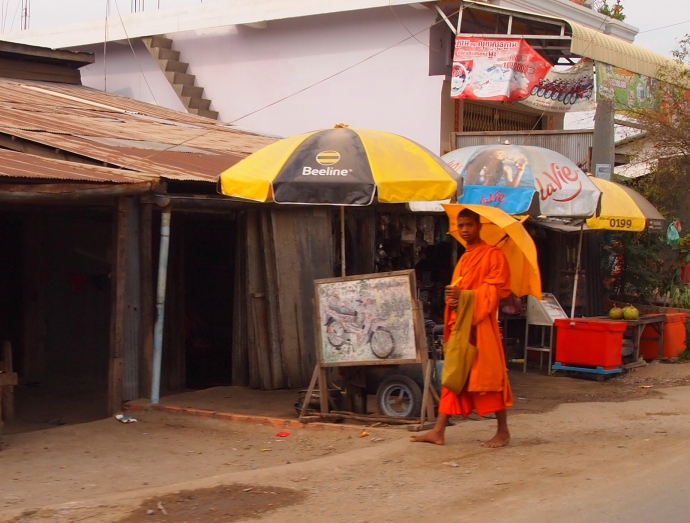
on the way to the Killing Fields
Barber shops seem to be everywhere, men standing with scissors in hand snipping away at customers wearing bibs around their necks. Children run around on the streets in dirty clothes with naked bottoms exposed. In the midst of the poverty, shiny cars with LEXUS emblazoned on their sides cruise the streets. Women walk the streets in cartoon-covered pajamas while men play billiards in open air concrete garages. In open-air movie-theater type rooms, sparse groups of people sit in plastic chairs watching a community TV set. Huge carts of stinky durians and leafy greens and bamboo and sugar cane are pushed by little old ladies in colorful mismatched outfits. Men covered in black oil toil away at engine repair shops, steel welding operations, or tire shops with corrugated tin roofs. Dust settles, permeates, resides.

the commemorative stupa at the killing fields
We buzz on. I have my backpack clutched between my legs on the floor of the tuk tuk because Mr. Lo warned me against keeping it on the seat. I have read that people snatch bags from foreigners as they drive by on their motorbikes. Corncobs cook on carts. Hyundai Porters (like I see constantly in Korea) and Toyotas roll down the poorly maintained streets. Surprisingly, I see a garbage truck, the first one I’ve seen in either Vietnam or Cambodia. I also see garbage dump-type places. The debris is not as prevalent here as what I saw on the fringes of Hanoi. The Cambodia-Japan Friendship Skills Training Center buzzes with people-in-training.
Forty-five minutes later at the Killing Fields, I face the entrance gate and a giant commemorative stupa. I discover later that the stupa is filled with the skulls of 8,000 victims who were murdered here. I go directly to the tiny museum where a film is in progress about the history of Pol Pot and his Khmer Rouge regime and of this place. The film is brutally honest and doesn’t try to gloss over the barbarity of this horrible regime. I find often in my travels that museums try to downplay the despicable actions of their country or to gloss over history. For example, in Musée de l’Armée in Paris, there is hardly any mention made of the Americans liberating Paris after WWII. You would think when visiting there that the French single-handedly defeated the Germans. Revisionist history.

the khmer rouge uniforms
The film here at Choeung Ek is truly sickening and brings me, and many other tourists, to tears. After the film, I collect myself, and walk around the grounds where I see some of the mass graves that were unearthed. There’s a grave where only naked women and children were found. Another grave contained headless corpses. Yet another only miscellaneous bone fragments. There is a tree where the regime would hold babies by the feet and bash their heads against the trunk. Their rationale for killing babies was so that the children of victims wouldn’t seek revenge on the regime when they grew up. One sign says that this particular tree held a loudspeaker to drown out the screams of those being bludgeoned, so as not to disturb the neighbors.
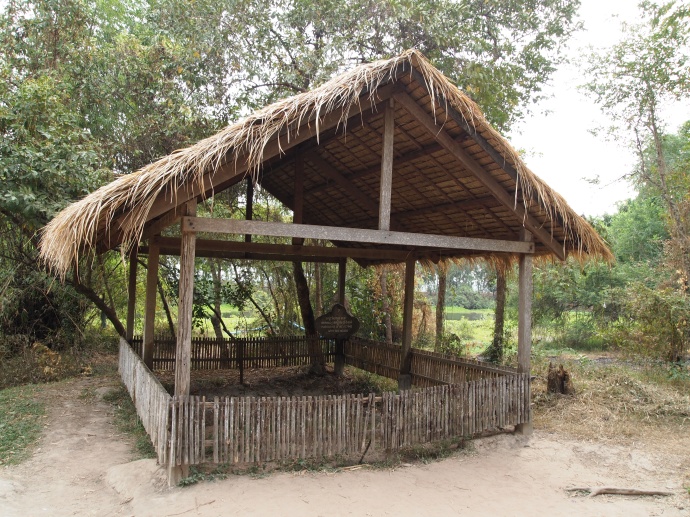
one of the mass graves
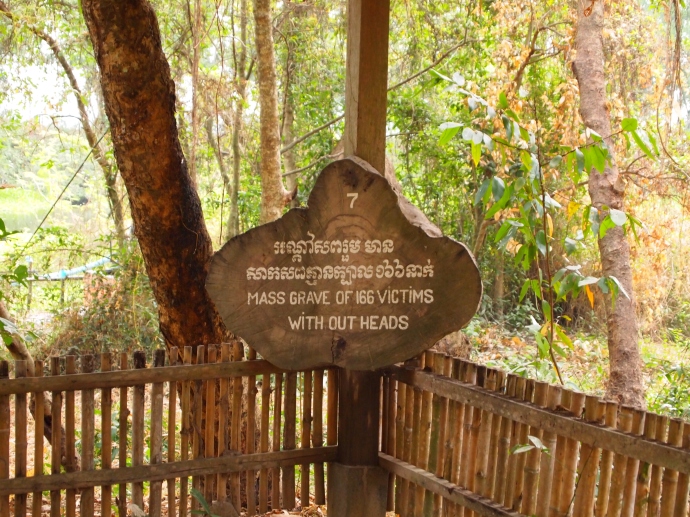
Mass grave filled with headless bodies

Choeung Ek
To save ammunition, the prisoners at Choeung Ek were usually bludgeoned to death with iron bars, pickaxes, machetes and many other makeshift weapons. Others were killed with poison, spades or sharpened bamboo sticks. Prisoners were often forced to dig the mass graves themselves, but as they were weak, the graves were often shallow. Even now, decades later, it’s said that clothes, teeth and bones surface during heavy rainfalls from the huge numbers of bodies that are still buried there.
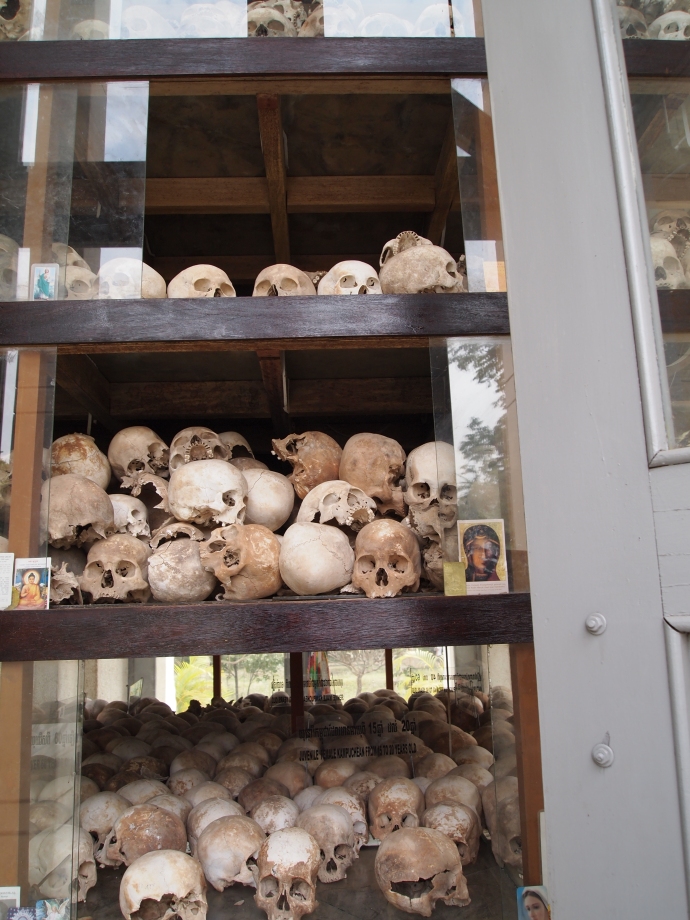
8,000 skulls in the stupa

Human skulls at the Genocide Museum

on the grounds of the Killing Fields
After this depressing morning, which is educational but emotionally draining, Mr. Lo takes me back to town and we go to Wat Phnom, meaning Hill Temple. It’s set on the only hill in Phnom Penh, more like a mound at 27 meters. The locals swarm all over the place. Here Buddha worship is taken to extremes; it’s big business. Inside the temple are hundreds of Buddhas, each of which is holding on its crossed legs or in its arms several Cambodian Riel, bananas, oranges, flowers, or little skewers of white flowers that smell like freesia (I can’t find the names of these flowers anywhere!). I walk behind a young Cambodian guy who devoutly walks around the perimeter of Buddhas, bowing and placing a Riel on each Buddha.
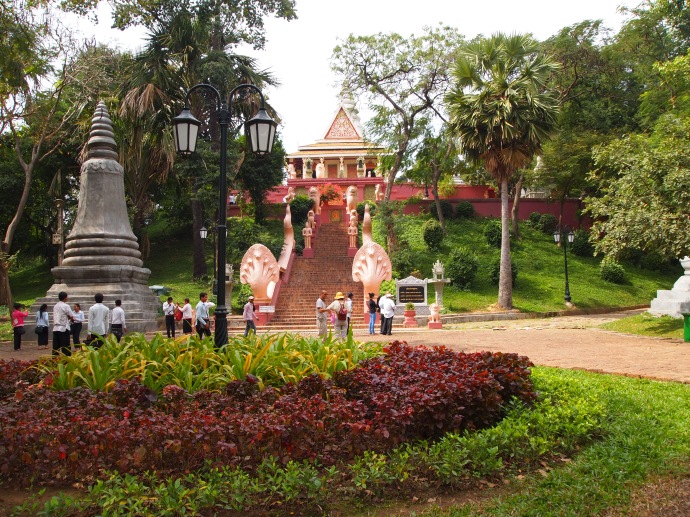
Wat Phnom

Wat Phnom
There are easily 25-30 people within the temple busying themselves arranging or collecting or distributing the multitudes of offerings. Others are on their knees praying. Outside in the back are other smaller Buddha statues in front of which, on a beautifully colored quilt, other food and fruit and flower offerings are placed. As soon as the quilt gets full, a man promptly gathers up the offerings. Further back on the hilltop behind the temple, I find schoolchildren eating the fruit that has been removed from the Buddhas. On the far right of the temple is a production area where people are arranging flowers, cutting fruit, burning incense, slicing raw meat and offering these items for sale.

the buddha clutches his offerings at wat phnom
I come across several stone dog figures with panting mouths; in their mouths are strips of raw bacon and under their sitting figures are raw eggs that have been cracked open and are slowly hardening in the heat. Then I see other men and women come by to take away the bacon and the eggs. It’s commerce at its liveliest, this Buddha offering activity. All abuzz. It’s like the altar guild decorating for Christmas Eve service in an Episcopal church, except this occurs every day. Outside the temple are young boys with birds in cages. I ask someone later what that’s all about; apparently they sell the bird’s freedom to people who want to earn merit with the Buddha. Later, the birds return to their cages, where they are resold and resold and resold, an infinite number of times.
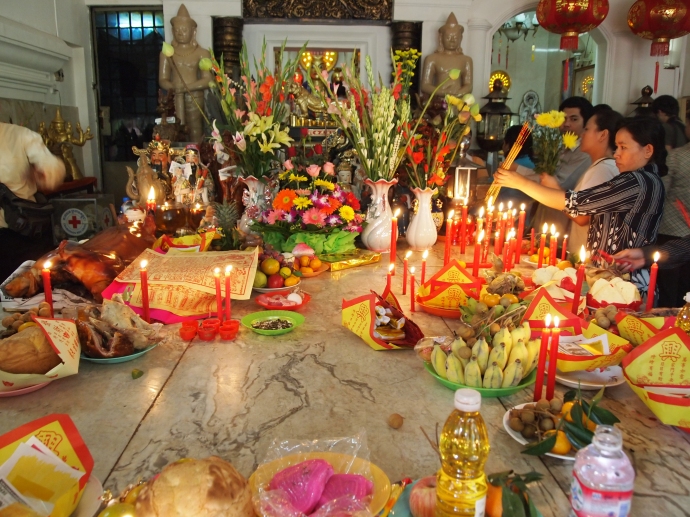
the production center where offerings are bought and sold at wat phnom
Legend has it that in 1373, the first temple at Wat Phnom was built by a lady named Penh as a home for four Buddhas that she found floating in the Mekong River.
Mr. Lo then takes me to Wat Ounalom, the headquarters of Cambodian Buddhism, which is beautiful but deserted. Apparently it has one eyebrow hair of the Buddha himself, but I didn’t see it. Later, when we leave the Wat and are cruising down the main road in Phnom Penh, two ladies and a child on a motorbike drive by and strike up a conversation with Mr. Lo. After they speed off, he tells me, “That was my wife!!”

the riverside restaurant where i have lunch
While we have been cruising in the tuk tuk around Phnom Penh, I see a riverside restaurant that reminds me fondly of the Grand Cafe on the Nile in Ma’adi, a suburb of Cairo. I tell Mr. Lo I want to go to this cafe for lunch and since the Royal Palace doesn’t open till 2:00, he drops me off here. I have about an hour and a half, so I order a Tiger beer, which they serve with miniature peanuts with the skin still on them, smothered in salt. The surrounding tropical plants whisper in the breeze. I hear the buzz of construction activity on the river, the roaring engines of cranes moving the mud in the river, the clanking of an anchor on a riverboat. In the restaurant, I hear the nasal sounds of Asians talking, the whining Khmer music.
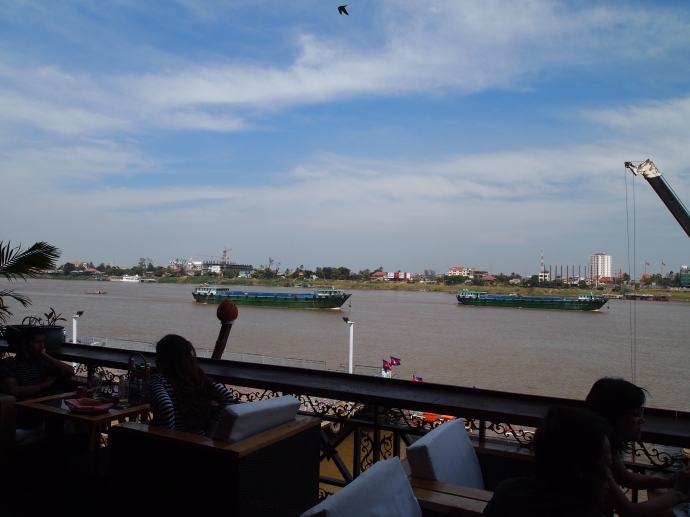
my view of the river
My meal of fresh steamed fish in lime juice arrives, artfully prepared, with three banana leaf cups full of peppers and sauces.

lunch of steamed fish with lime juice & leaf bowls of sauces
Later, as I write in my journal and watch the people and the activity on the river, I have a glass of red wine. It’s quite lovely and relaxing, although the roaring cranes on the river ruin the ambiance a bit. The Grand Cafe on the Nile it’s not, but it’s pleasant all the same. I’m alone here after my first four days in Hanoi, where I was surrounded by people, but so far, I enjoy the solitude. I’m feeling a little buzz because of the beer and the wine, but it’s a relaxing wait for Mr. Lo to return for me.

elephants march through the restaurant
Though fellow travelers had told me Phnom Penh was nothing special, I would have to disagree. I find it quite pleasant. It’s warm, the skies are blue brushed with wispy white clouds. I see less pollution, less trash, a better infrastructure. It’s so civilized and genteel. Even though it’s poor, Cambodians seem to have a grace and elegance about them, much like the carvings of apsara (woodland spirit) dancers on their ancient temples. When they greet me, they put their palms together in a prayer position, bow their heads and say “Hello, Madame.” It’s quite charming.

drinks for sale in front of the royal palace
I realize that I’m happiest in travel when the temperature is just right and I’m dressed appropriately. If there’s a breeze, I’m even happier. If I’m comfortably seated or lying down, or walking along and it’s not too hot, if I’m clean and surrounded by relative cleanliness. If there is a sense of aesthetic around me. Although I find myself fascinated by the impoverished street scenes, looking at the commerce and people scrambling for a livelihood, I know that I couldn’t live in this environment. I’d be miserable for any length of time in such squalor.
In Korea, I live a very simple pared-down life, with just a small room, a few of my clothes, only a few belongings. It’s possibly one step above a monk. Maybe if I had to live like this forever, I wouldn’t like it. But of course I know I can go back to my 3-story house in Virginia, where I have beautiful furniture, lovely and comfortable surroundings. We in America are spoiled this way. We’re lucky. Most Cambodians and Vietnamese, even many Koreans, are not so.
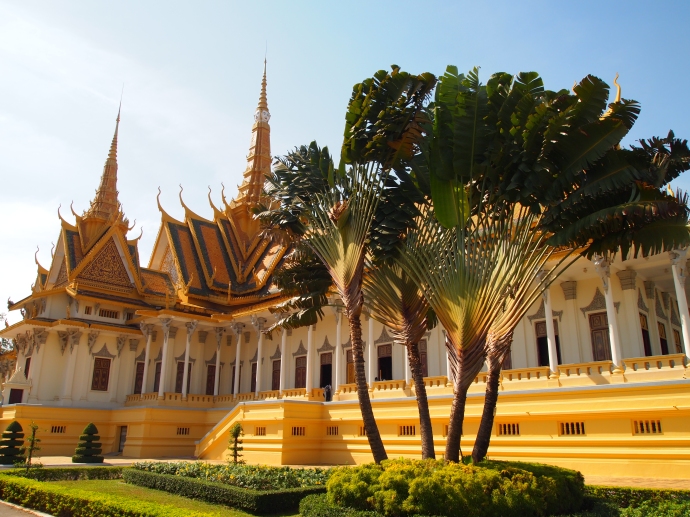
the royal palace
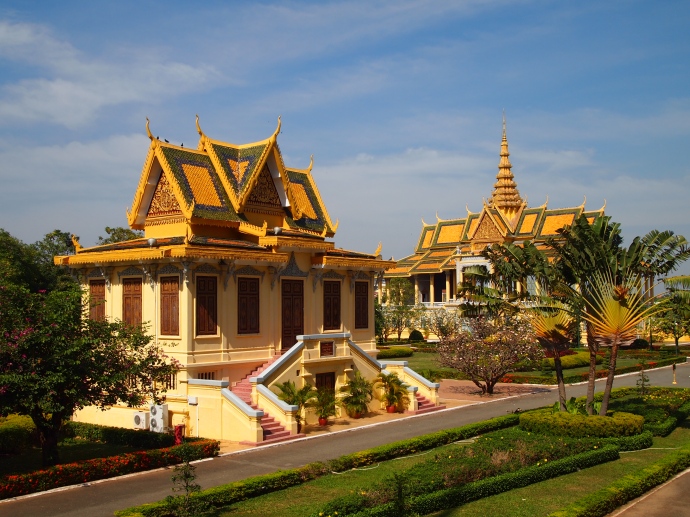
more of the royal grounds
Finally, after lunch Mr. Lo returns for me in his tuk tuk and takes me to the Royal Palace and the Silver Pagoda. The Royal Palace is a complex of buildings that serves as the royal residence of the King of Cambodia. The Kings of Cambodia have occupied it since it was built in 1866, except during the tumultuous period of the Khmer Rouge. Now, in the afternoon, it is quite hot. The Royal Palace is lovely, all yellow buildings with curlicue roofs, in classic Khmer architecture. Making my way through the throngs of uniformed schoolchildren on field trips, I walk through the Throne Hall, where today religious and royal ceremonies are held. The students are chattering, giggling and yelling, putting their spin on the relative peace. I snap a photo but a guard yells at me that no photos are allowed. Too late.
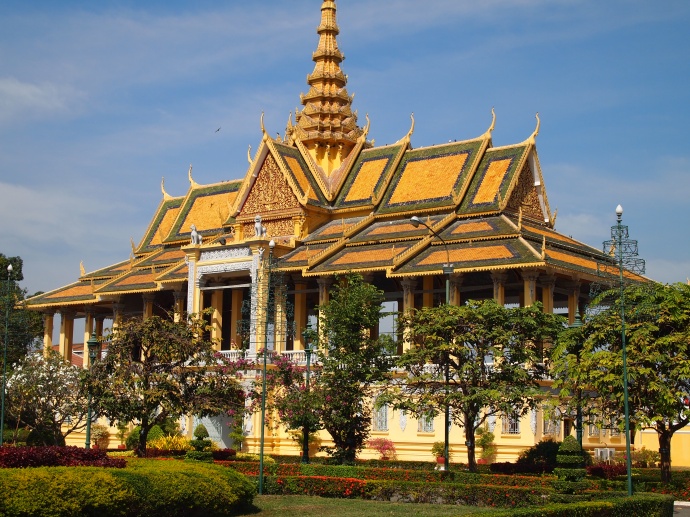
part of the Royal Palace complex
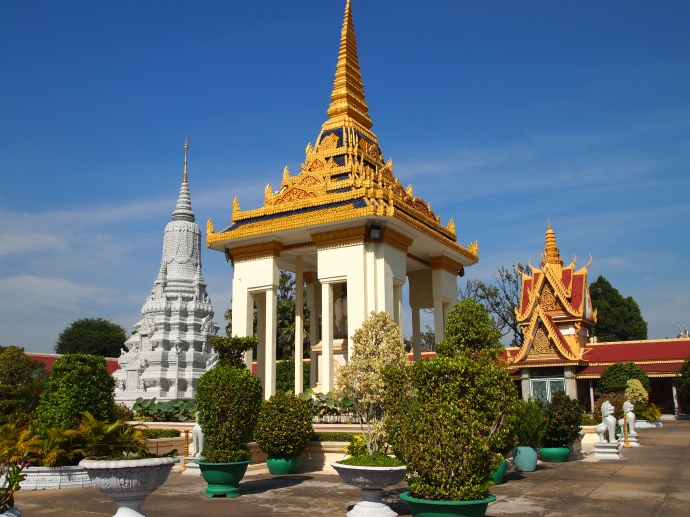
on the grounds of the Royal Palace
Later I walk around the gardens looking for the Silver Pagoda, but I don’t see any silver buildings. Finally, I ask someone and they point out a building I have already been inside, which certainly does not have the silver exterior I expected. Inside the building, no photographs are allowed. It houses a beautiful 17th century Emerald Buddha, which I certainly WANT to take a picture of, but with all the guards hovering, I don’t dare. It also boasts a near-life-size Buddha studded with 9,584 diamonds and dressed in royal regalia. Apparently, before the Khmer Rouge, the temple floor was inlaid with 5,000 silver tiles, thus the name Silver Pagoda. Most of this floor today is covered up with carpeting.
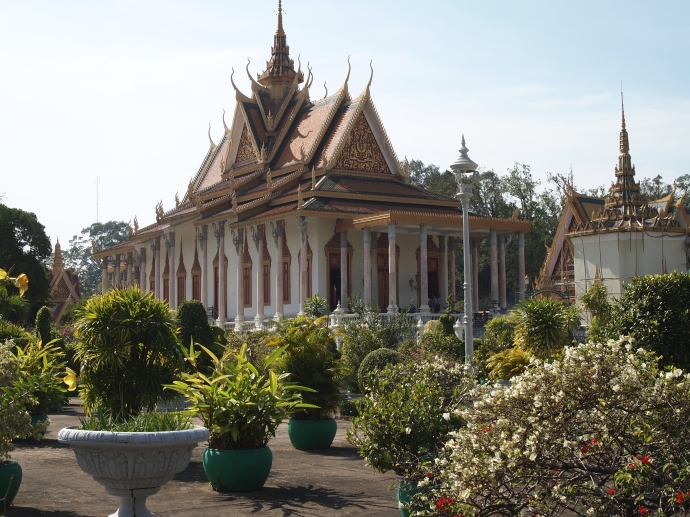
the silver pagoda

a mini shrine in front of the silver pagoda

painted murals at the royal palace
I spend quite some time wandering through the Royal Palace grounds, checking out the gardens with their beautiful flowers and topiary, the faded murals on the walls, Buddhas sitting serenely in little gardens, and the elephant room with its decadent elephant thrones.
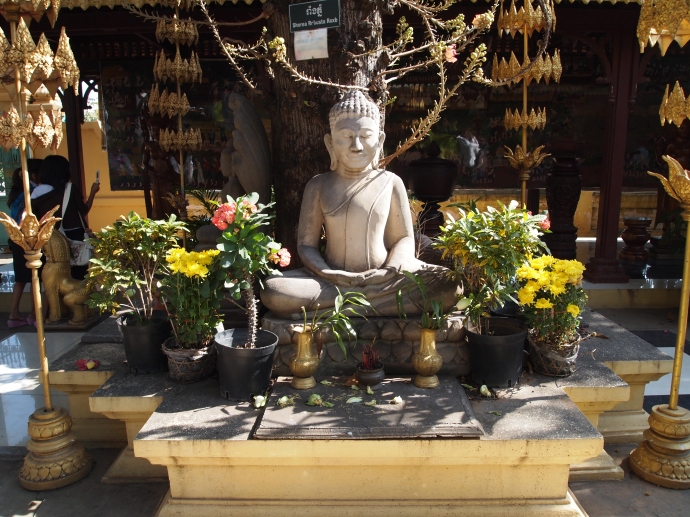
on the grounds of the Royal Palace

a Buddha in the garden
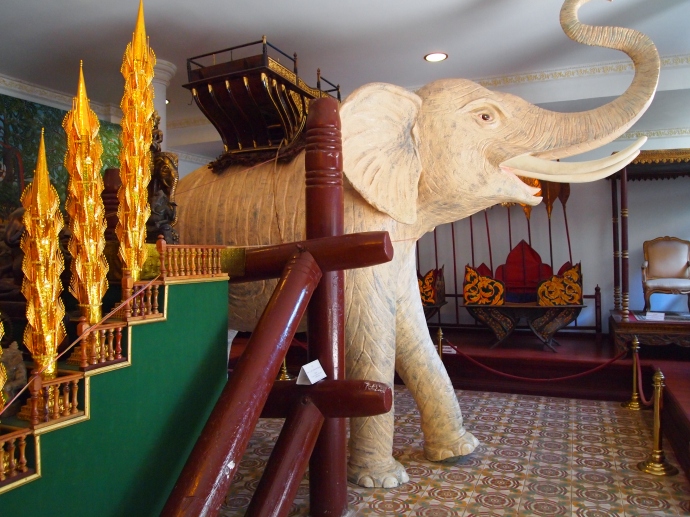
the elephant room with the elephant thrones
Later, I exit to find Mr. Lo patiently waiting. He takes me back to the Villa Langka. I had told him originally I’d give him $20 for the day, but knowing that he has patiently waited for me all day, taken me far afield to the Killing Fields, and been genteel and polite beyond anything I could have expected, I give him $25. This is quite a killing for him, as I understand you can generally rent a tuk tuk for the day for $8. I think the fact that I saw his wife ride up on the motorcycle also influenced my decision. He has a family to support; I saw a personal side to him…. I can’t help but wonder if this was a ploy on his part, to have his wife ride up beside us. But somehow, fool that I may be, I don’t believe this to be the case.

Lotus blossoms at the Royal Palace
At the Villa Langka, I put on my bathing suit and lie outside by the pool for an hour or so, reading The Eaves of Heaven. This is a great book, about the Vietnam War years from a Vietnamese perspective, but this afternoon I’m burned out from hearing and reading about war and violence and hatred. I so desperately need a love story, but alas, I have no such book with me. And I have no one here to be my actual love story. Sigh.
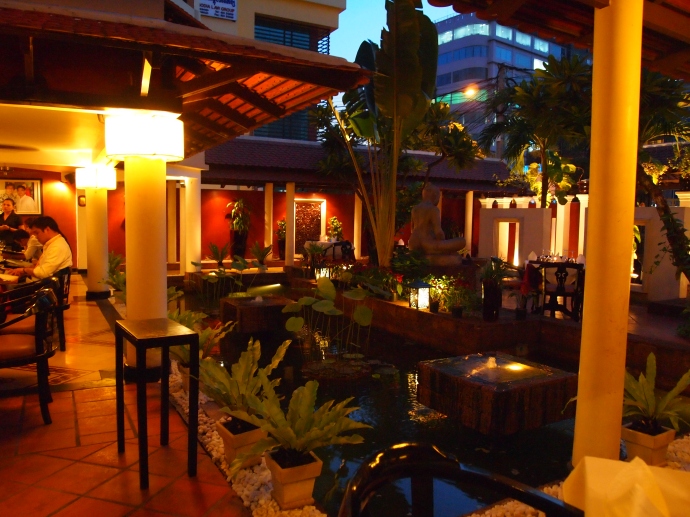
the stunning restaurant Malis in Phnom Penh
After relaxing by the pool and then taking a little nap in my daisy-petal white bed, I venture out to the Lonely Planet-recommended restaurant Malis, where a seated Buddha greets me at the entrance. The setting is stunning, a low-lit open air courtyard around an L-shaped pool brimming with lotus leaves. Giant palm fronds and bubbling fountains create a peaceful atmosphere. I can see the kitchen staff in bright white baseball caps bustling about in the gleaming modern kitchen.

my ugly but delicious fish dinner
I have a glass of red wine because the dinner I order, baked goby fish with mango dips, takes 45 minutes to prepare. Since I’m alone and 45 minutes goes by slowly, I have another. The fish arrives with scaly skin and a viciously ugly head, but the fish flesh is tender and delectable, especially with the refreshing mango dips. For dessert I have the Malis Signature Mousse, a “delicate mousse infused with jasmine, ginger and Khmer honey with a side of fresh fruit salad.” Mmmm….

my last night at the villa langka 😦 ~ the pool by night
I’m tired from my full day, and I have to leave tomorrow morning for Siem Reap, so I go back to my room and stretch out. I can’t get motivated to read my war book anymore, so I watch The Bachelorette on TV, a tiny taste of a love story gone awry (as most of mine do!). Sleep, precious sleep.







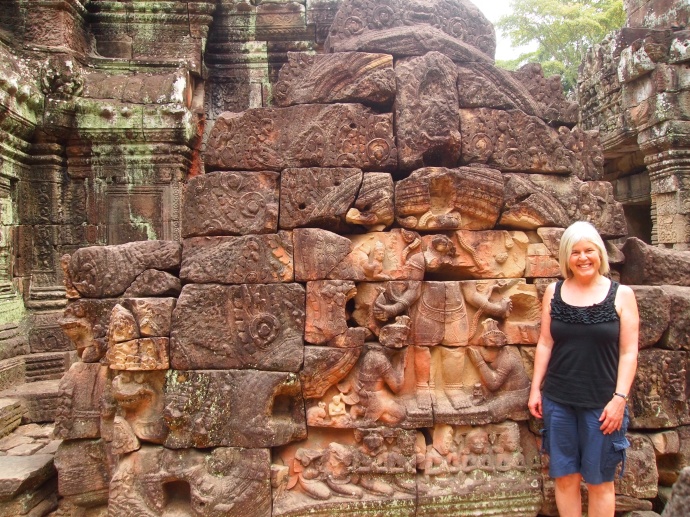


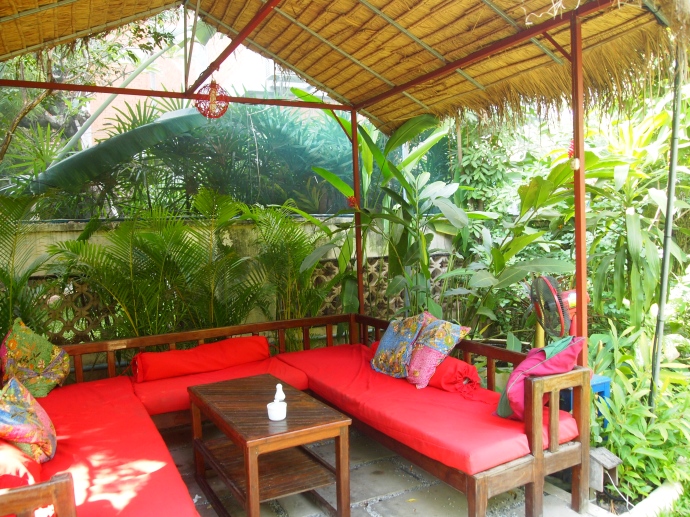
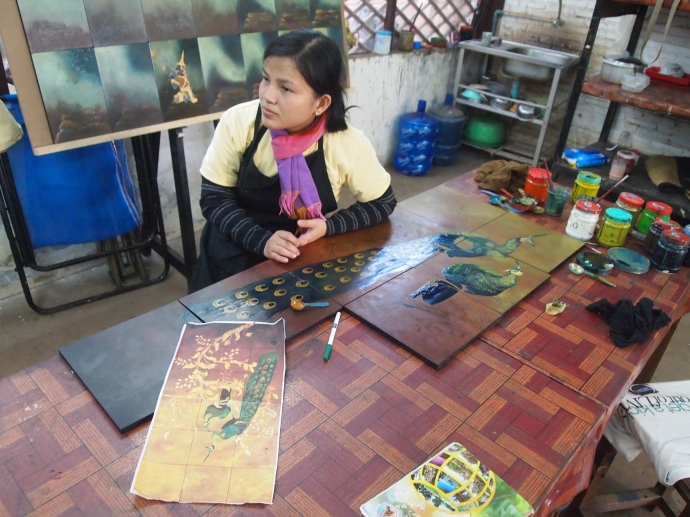









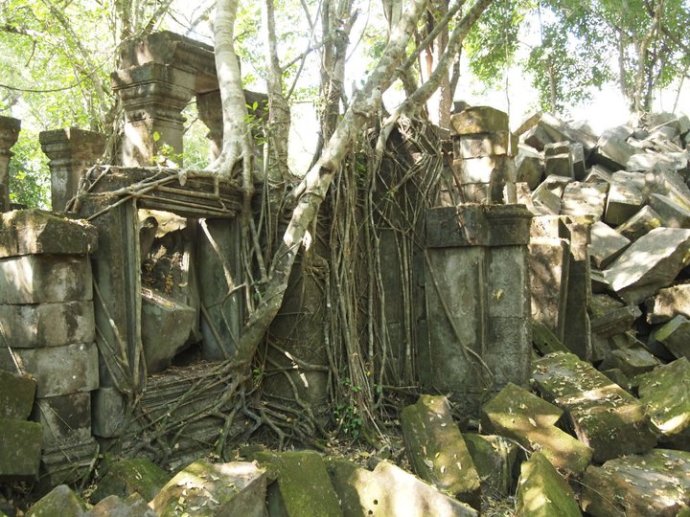



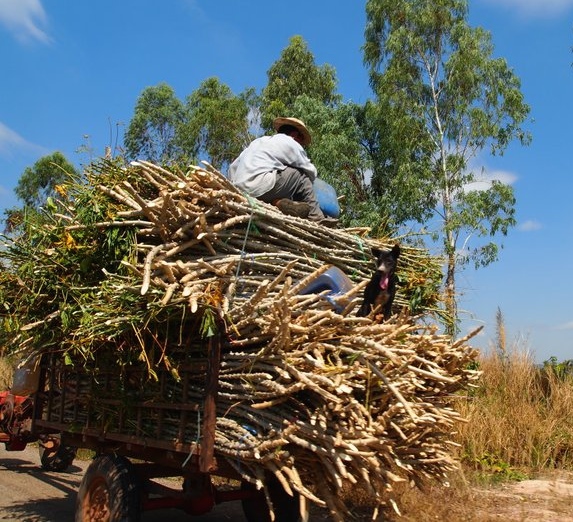

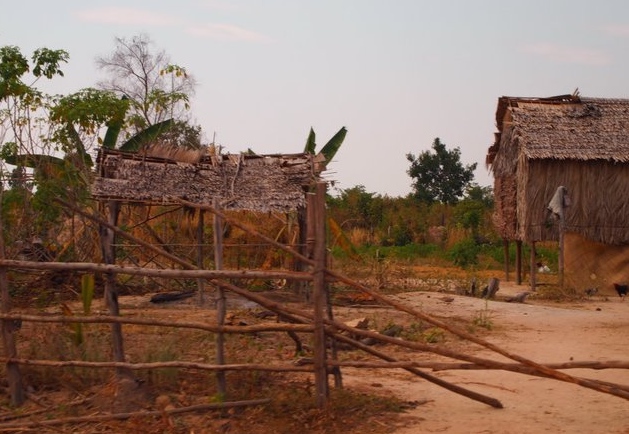
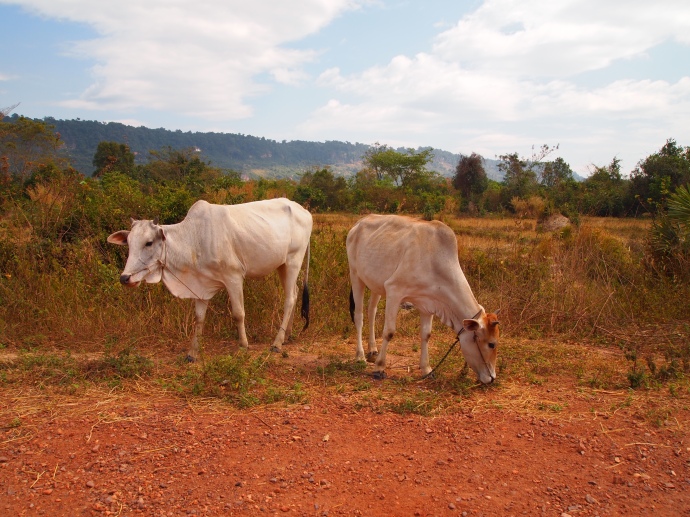



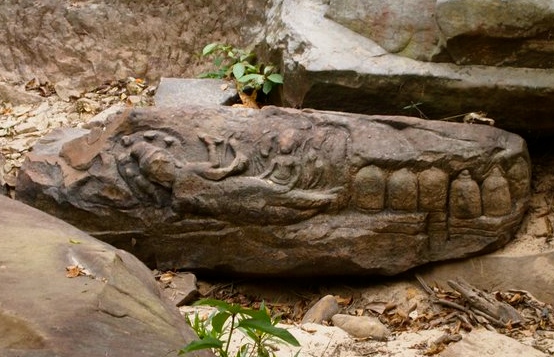
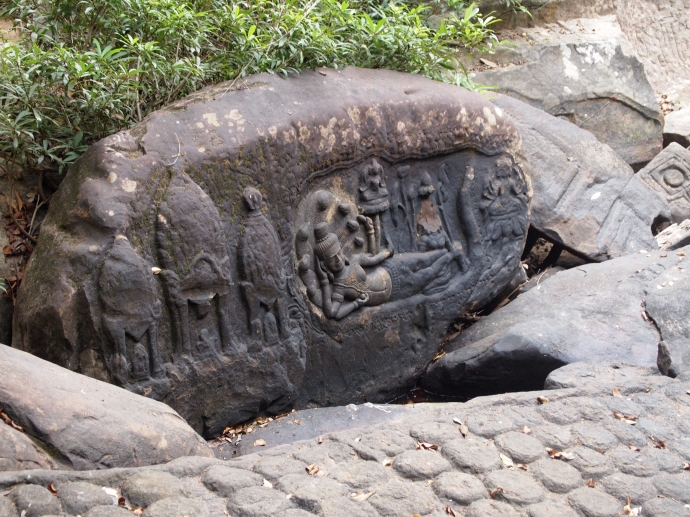
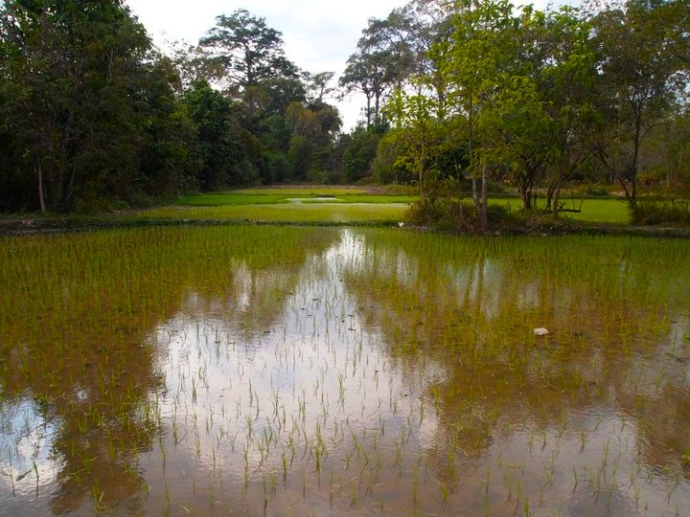


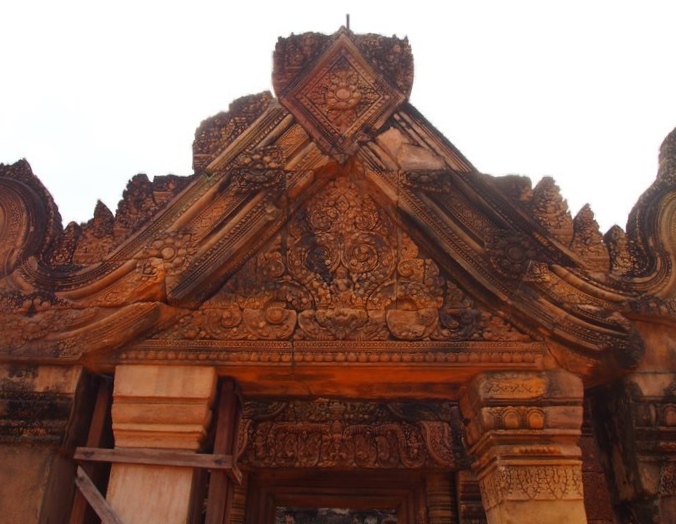
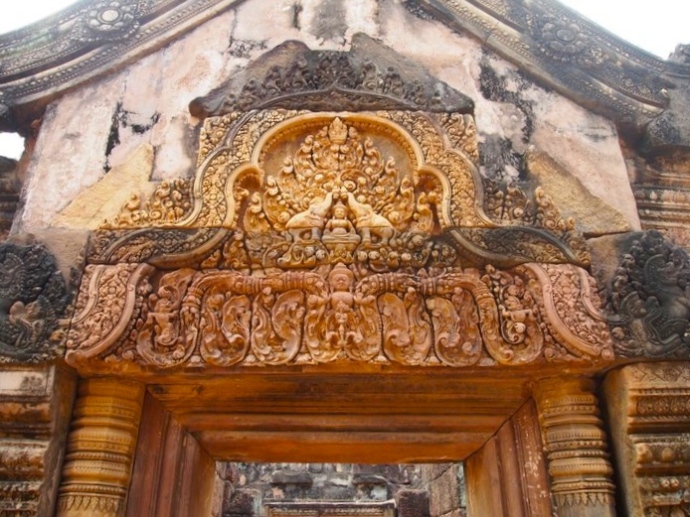




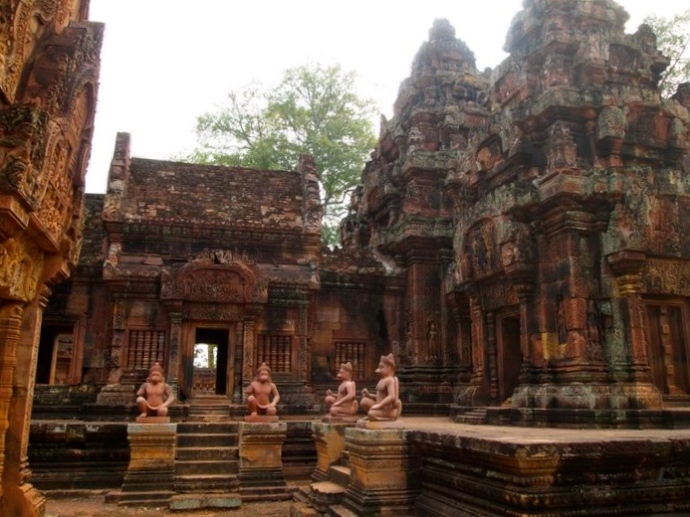
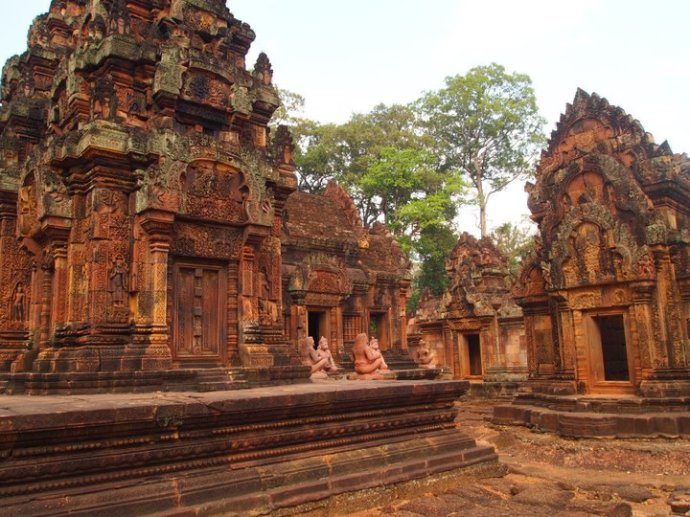
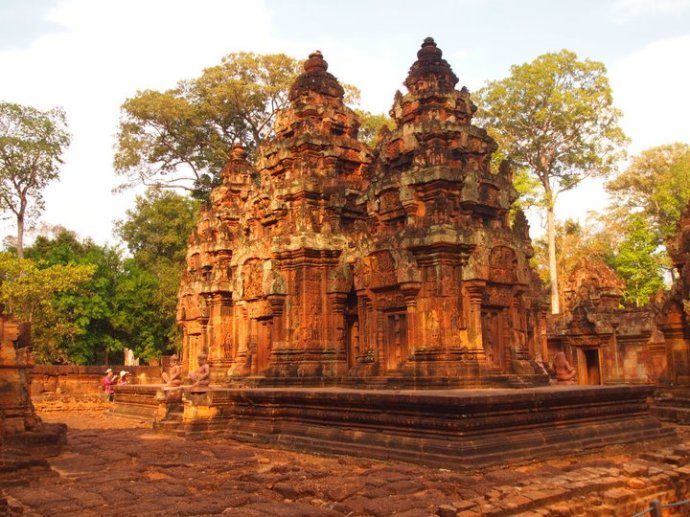
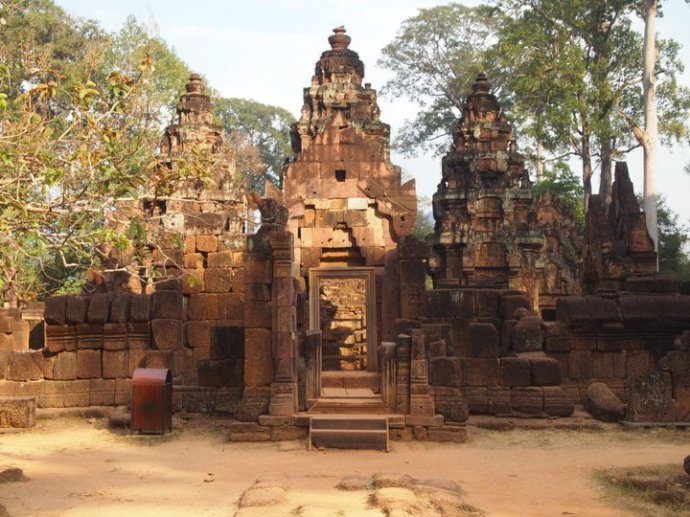
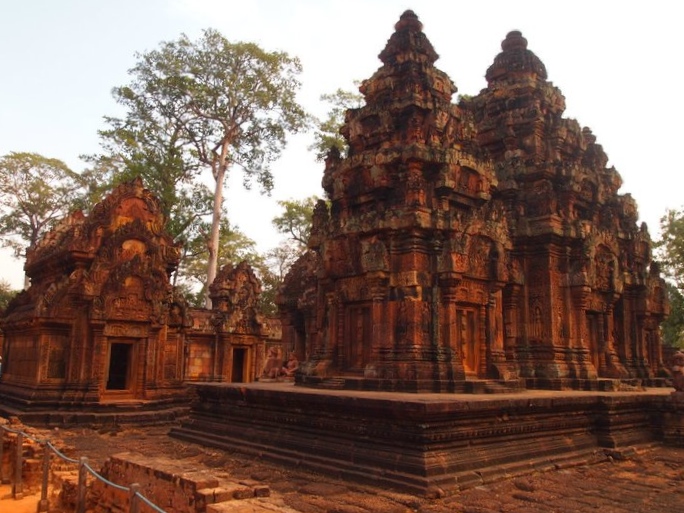
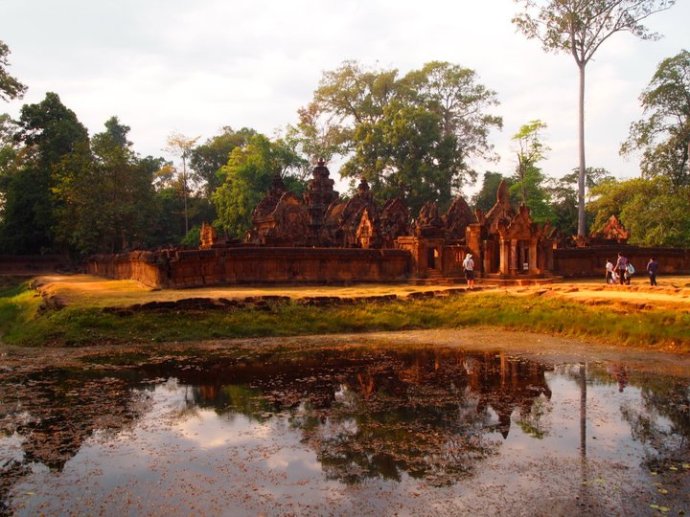

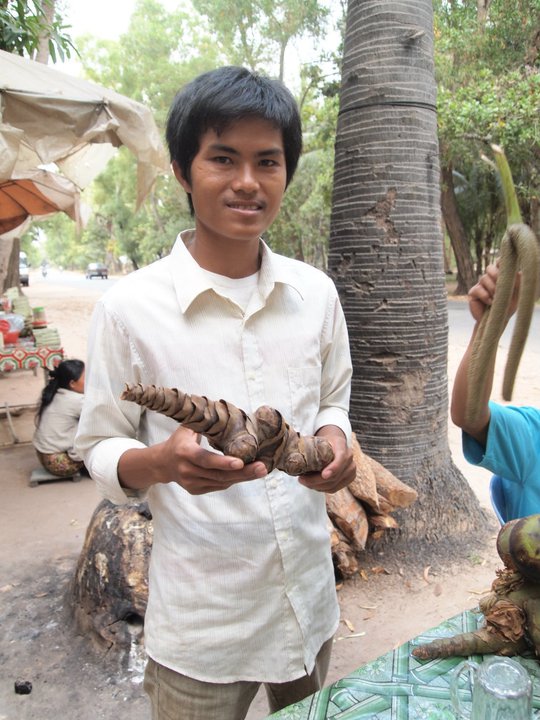






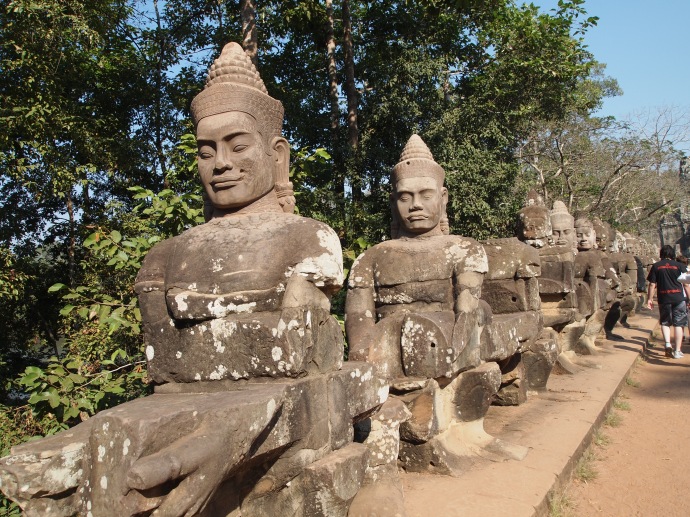
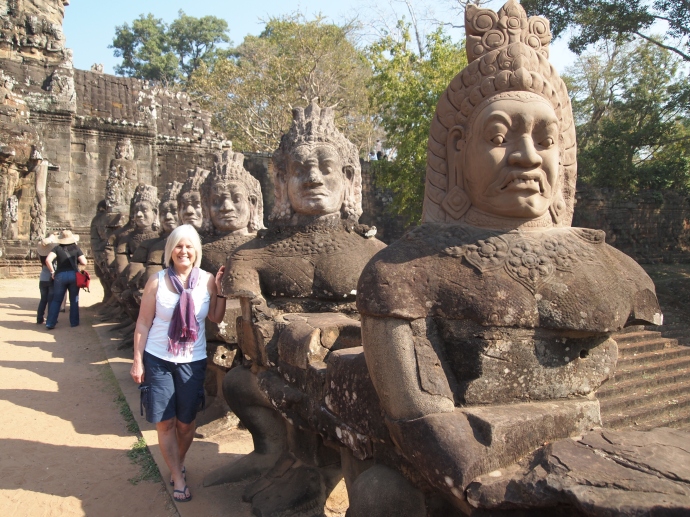




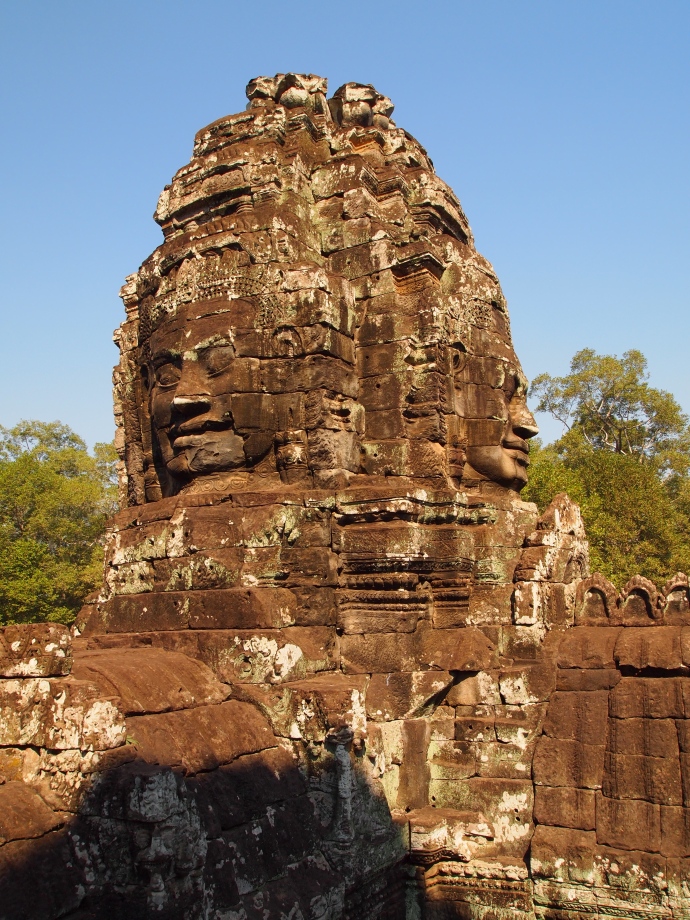
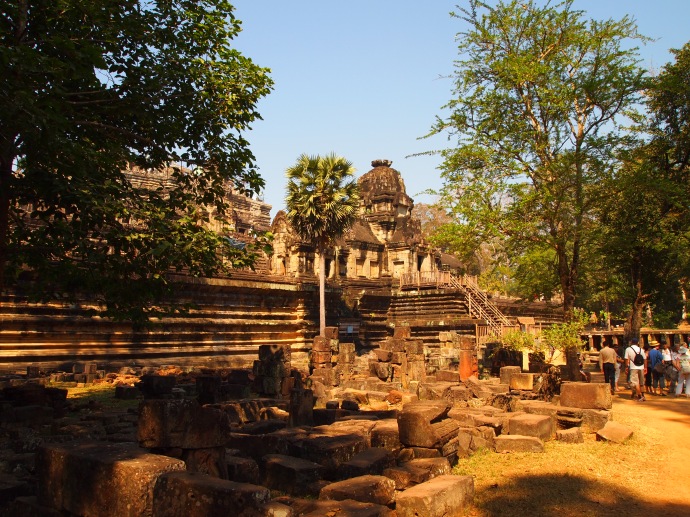
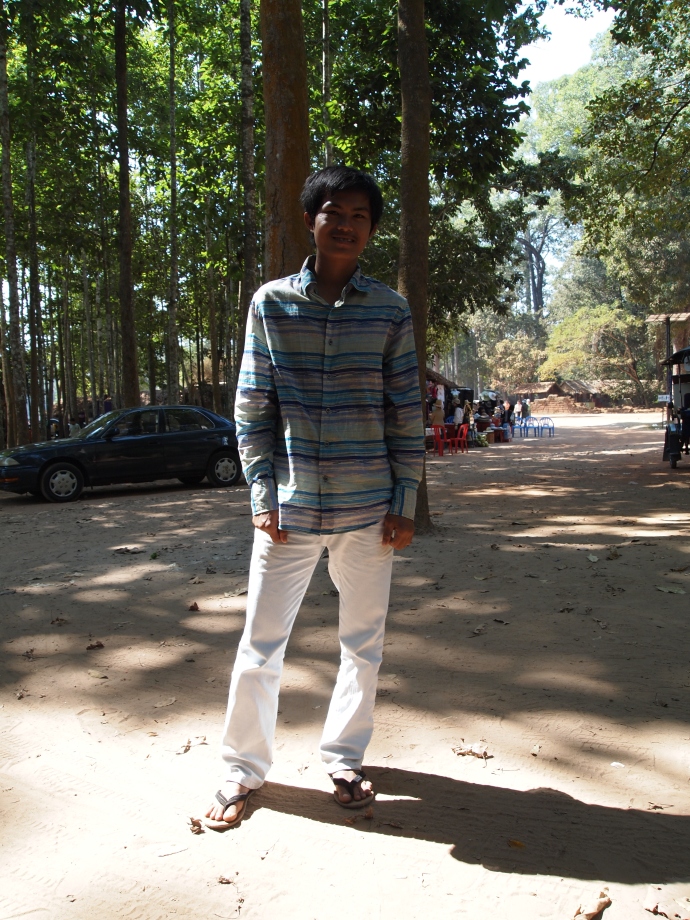





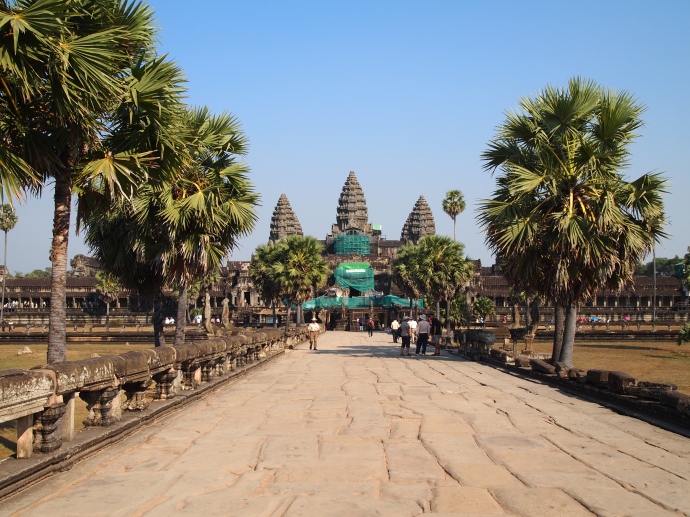

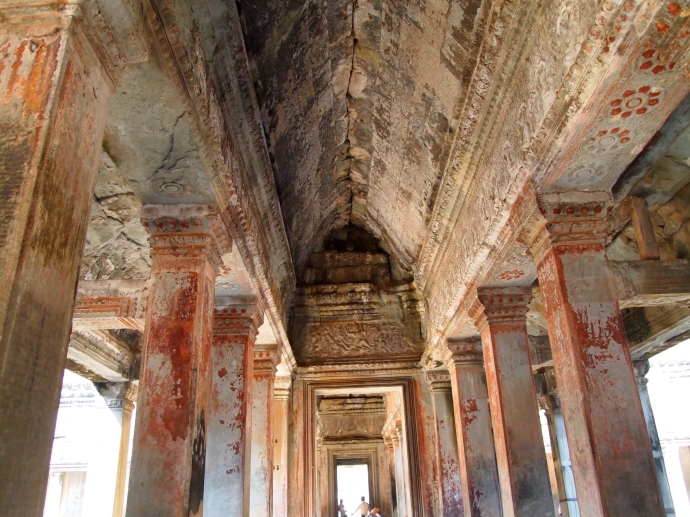
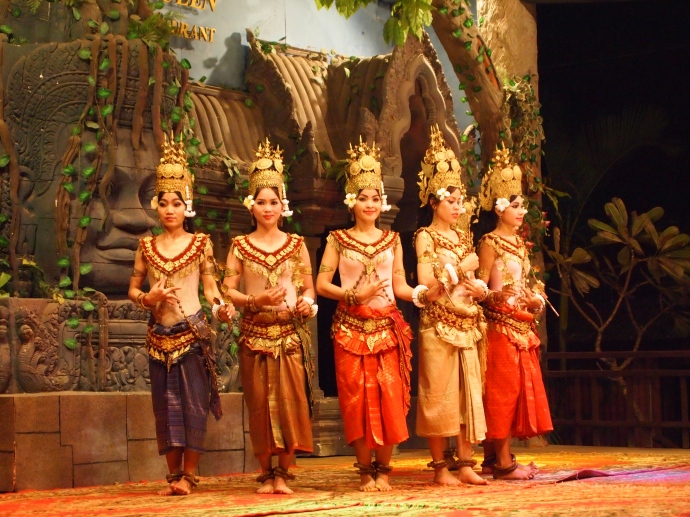



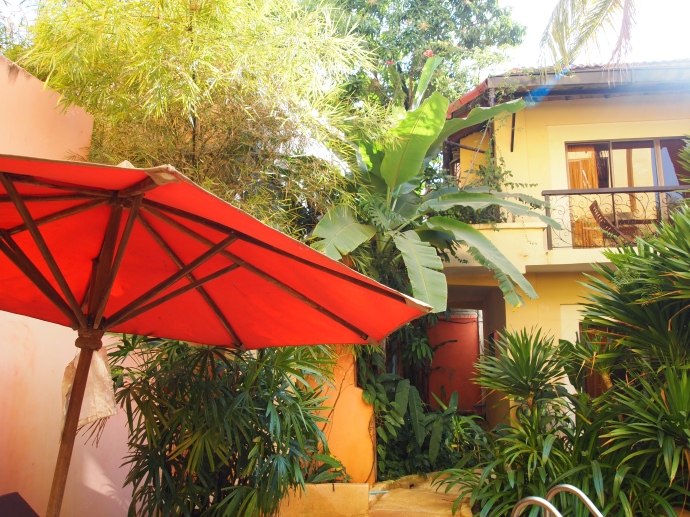
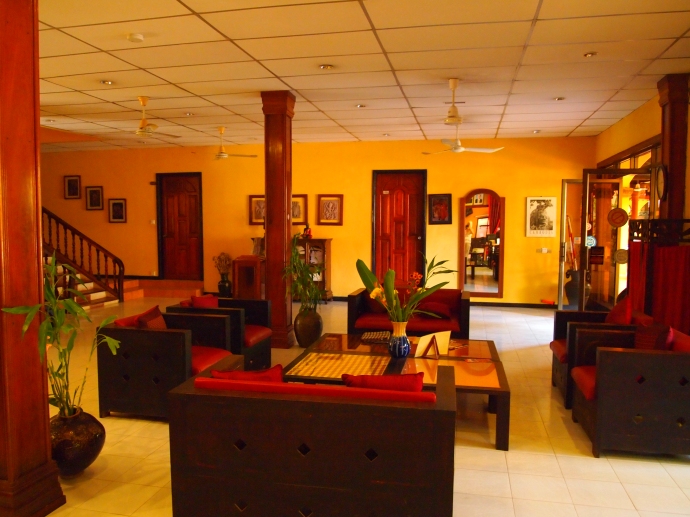
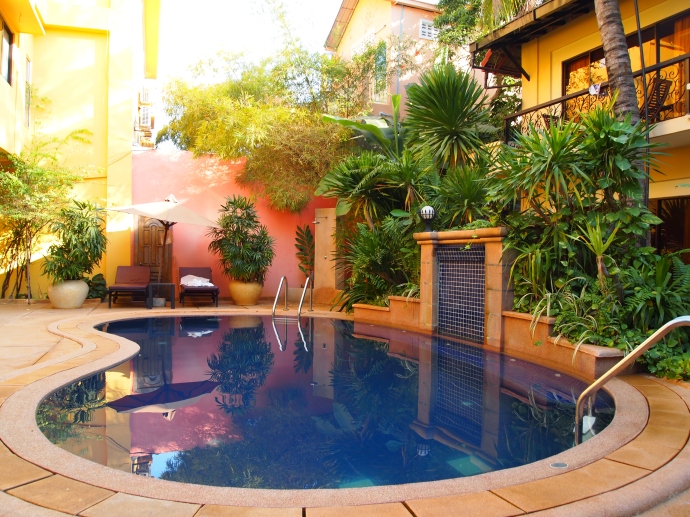
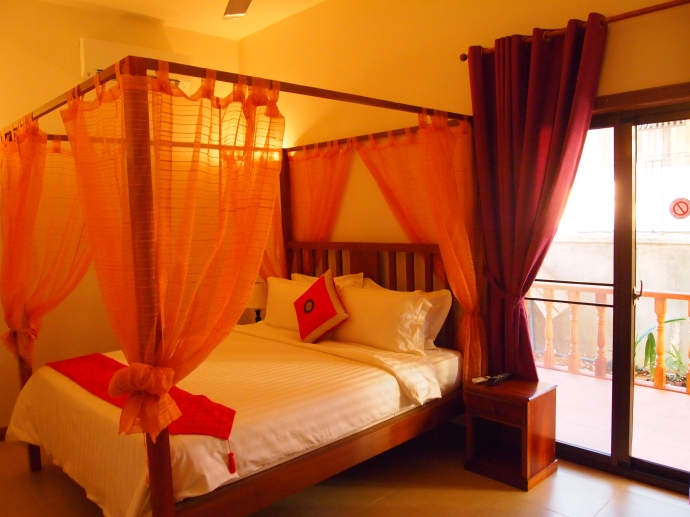
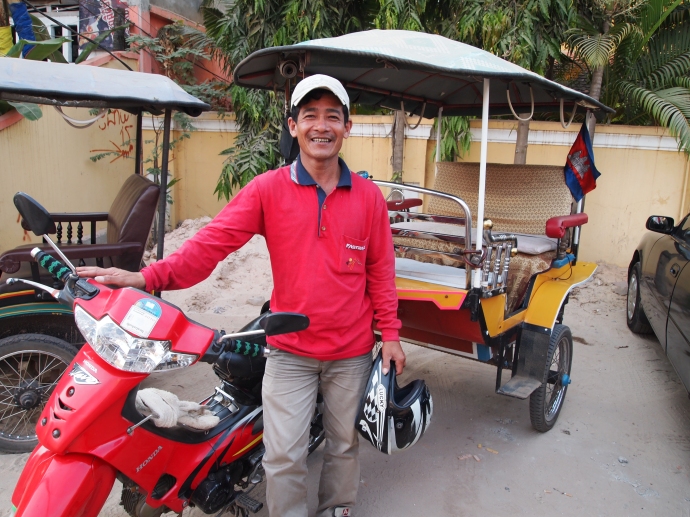


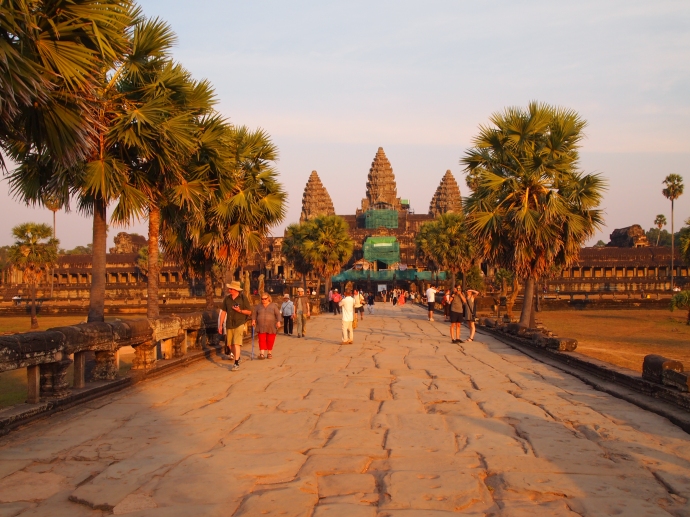
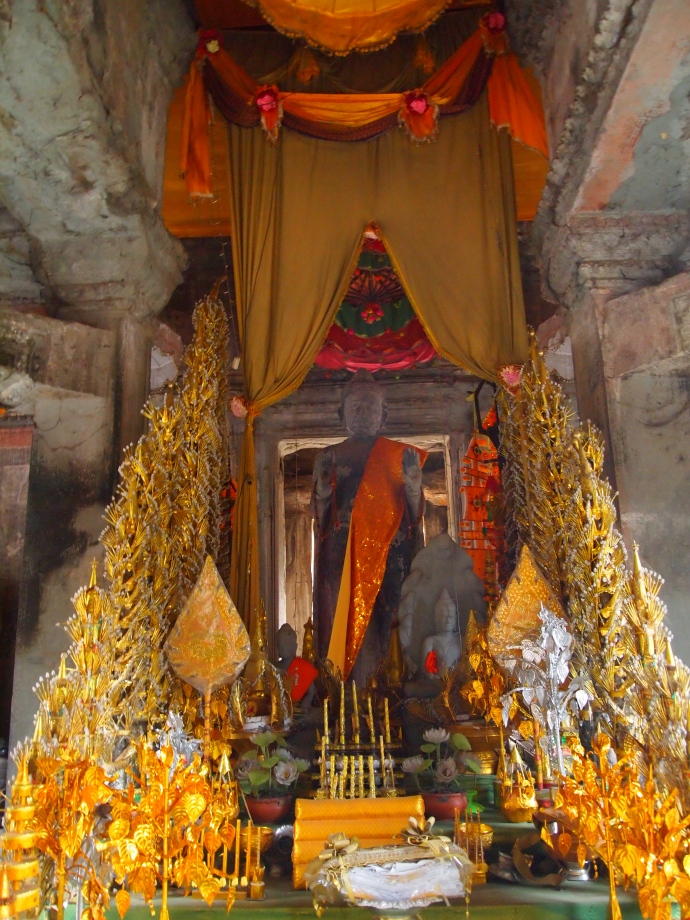
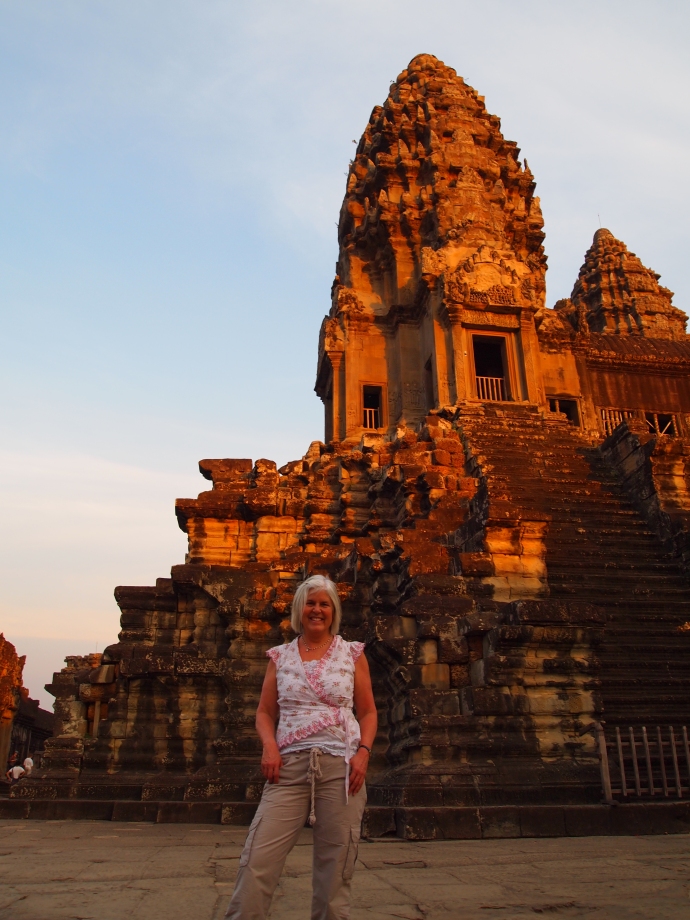
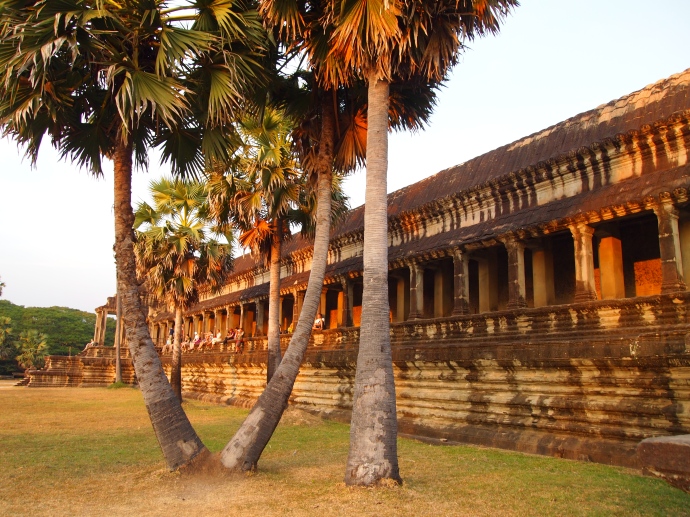

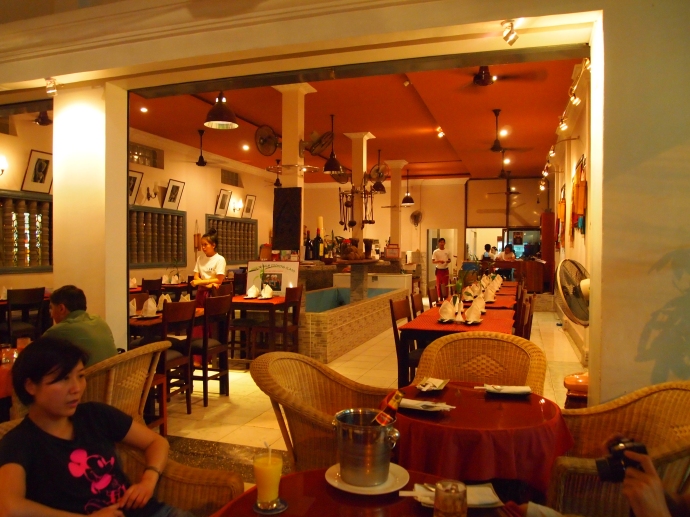



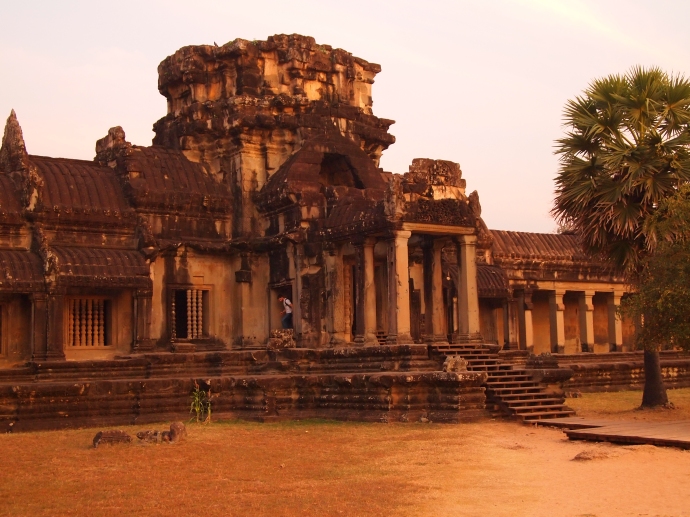









































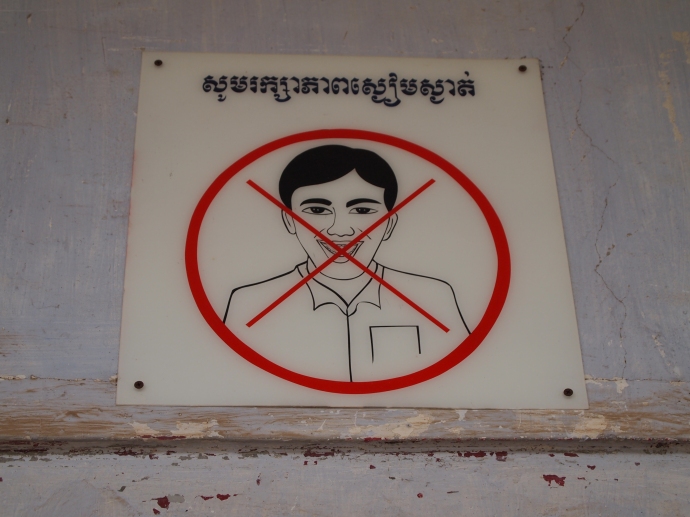

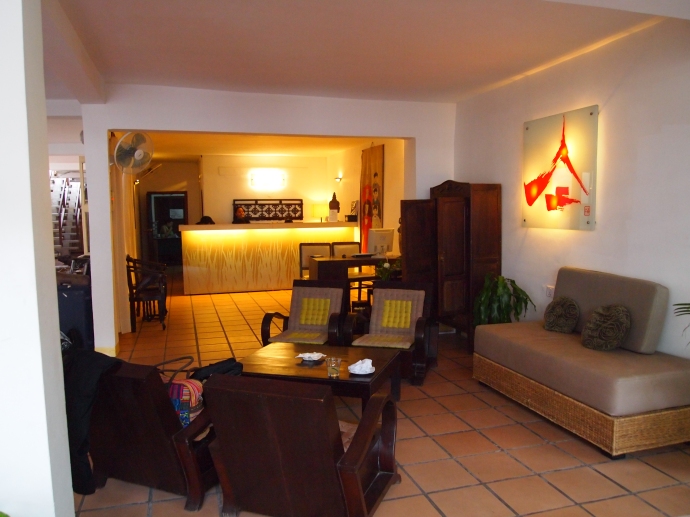
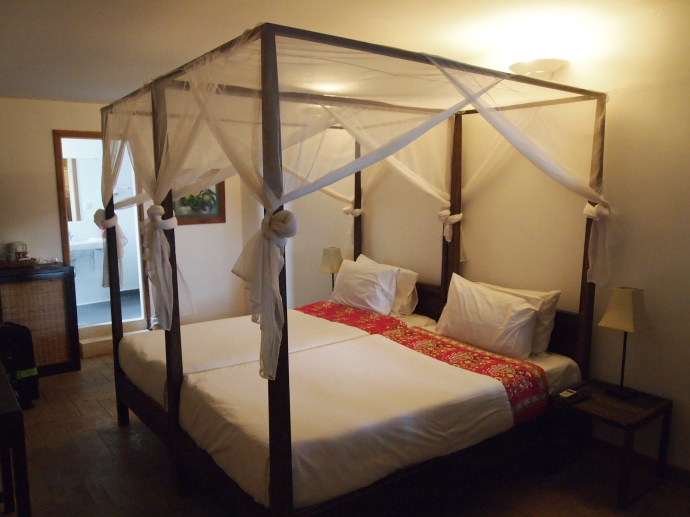
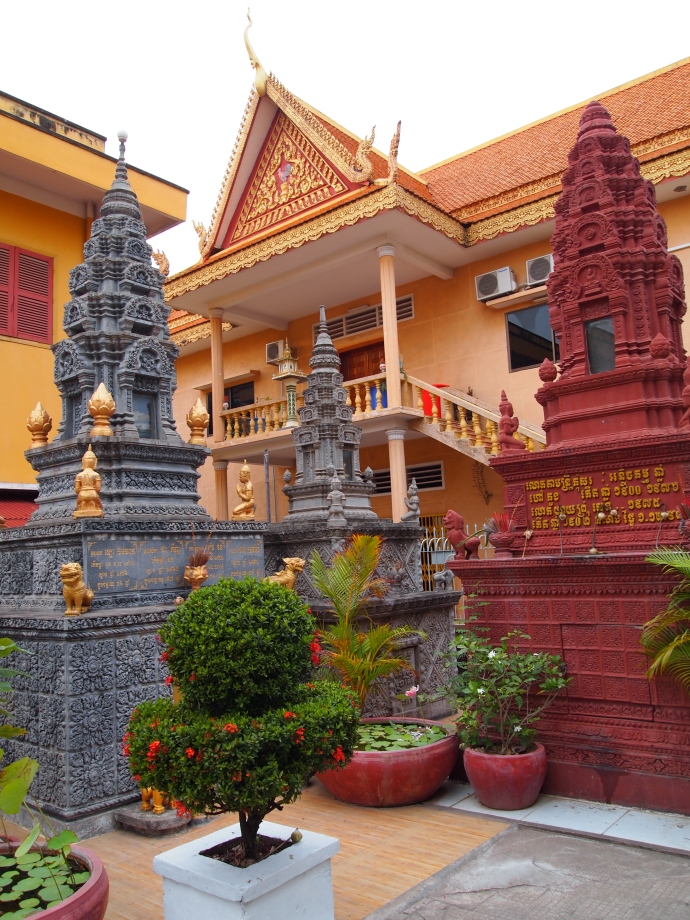

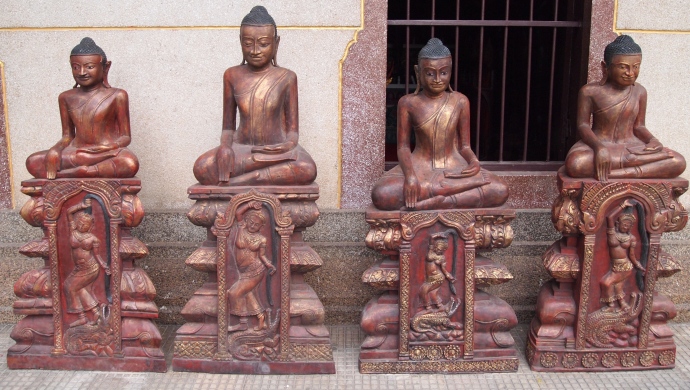
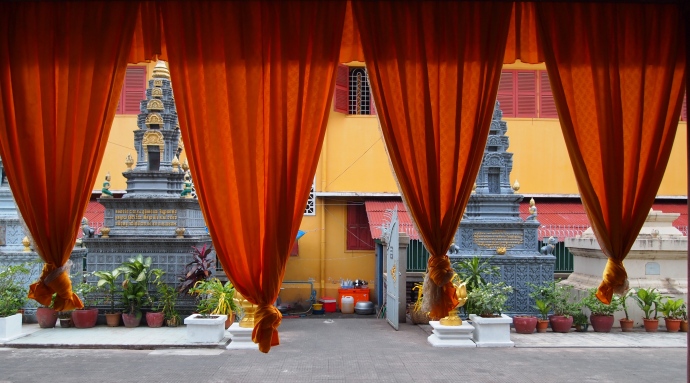

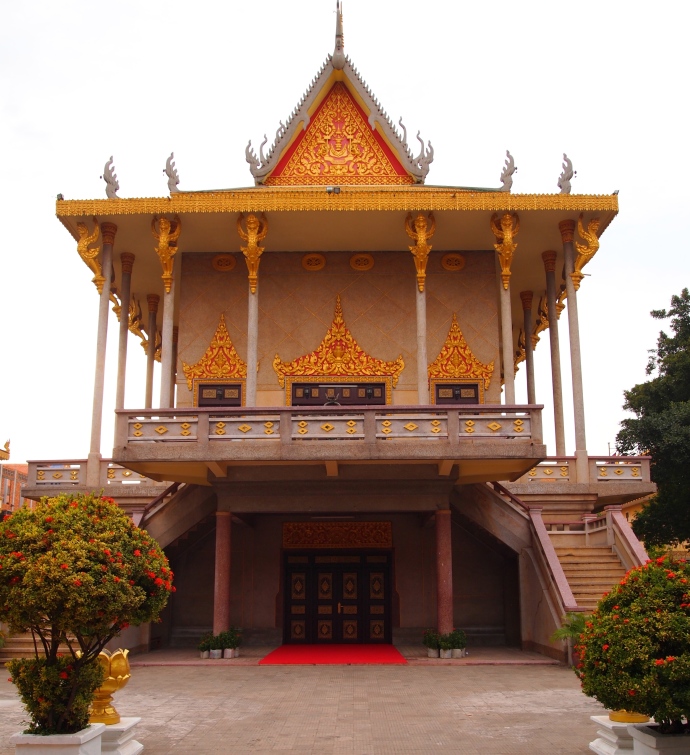



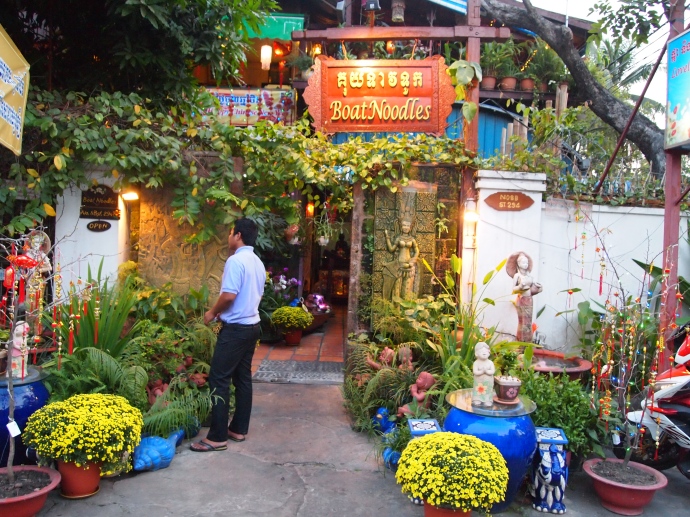
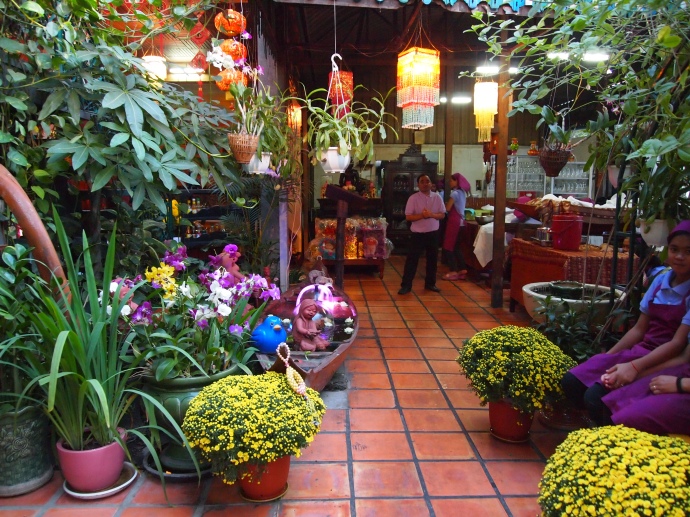

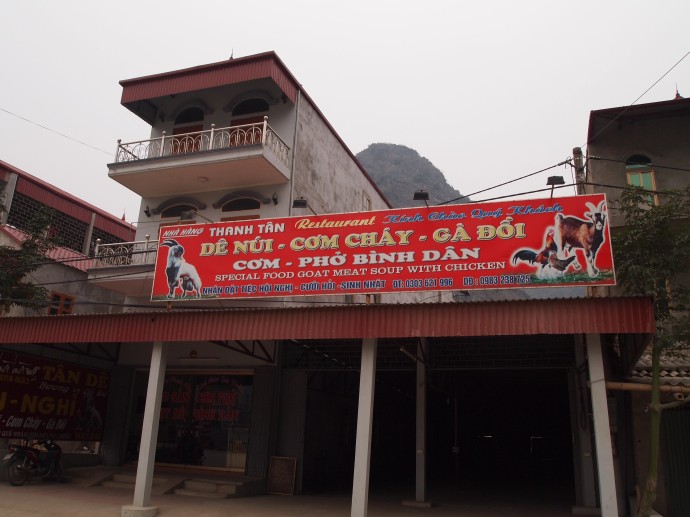
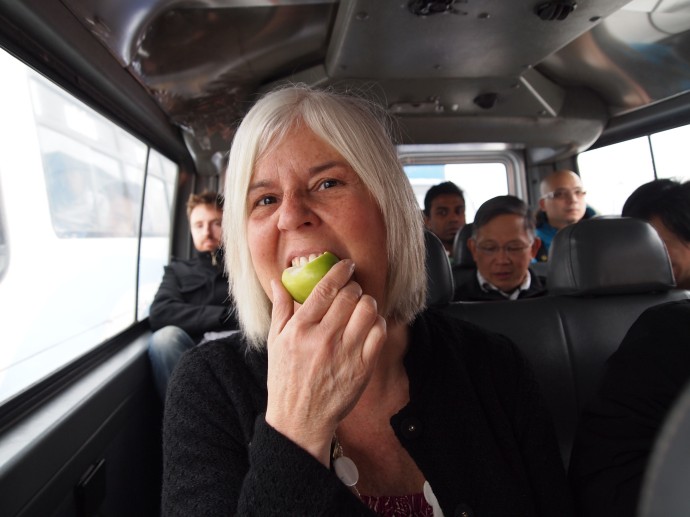

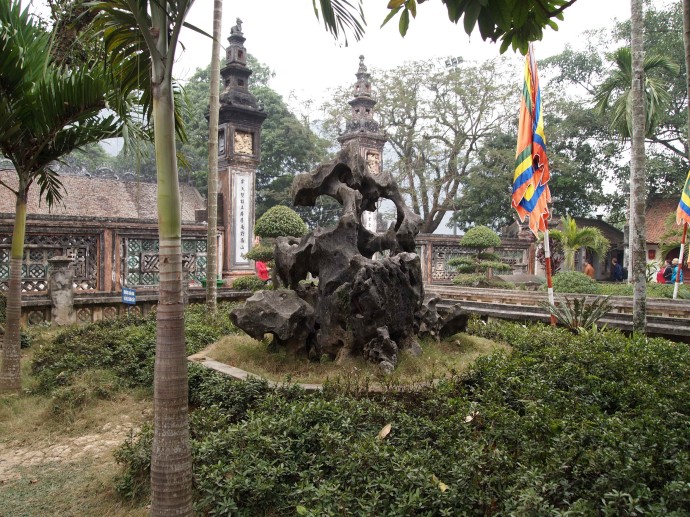
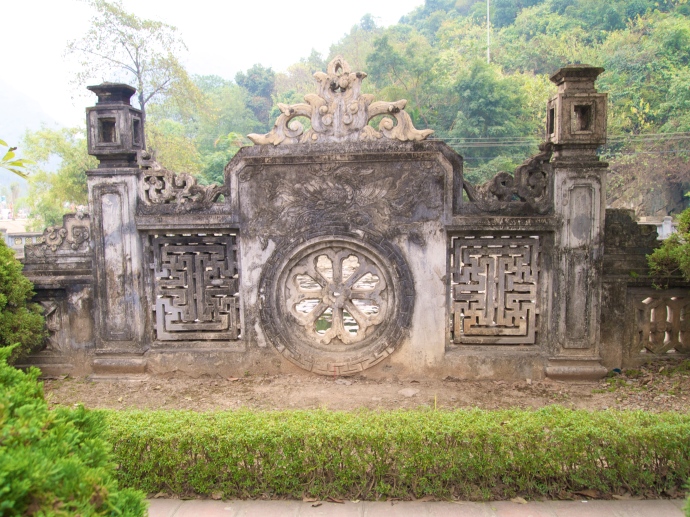

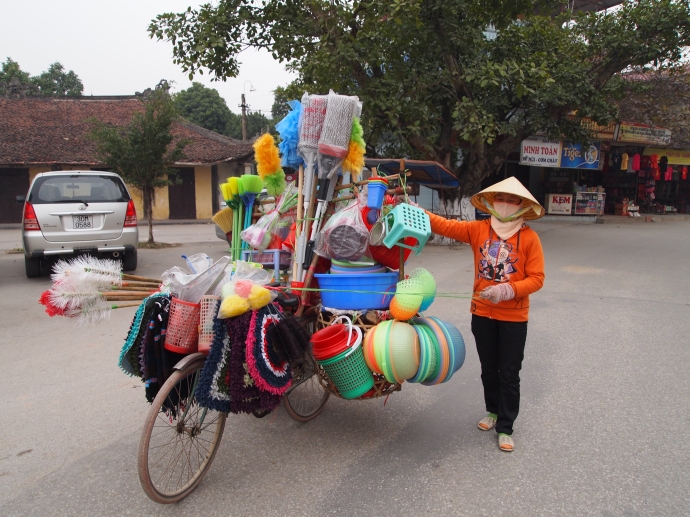

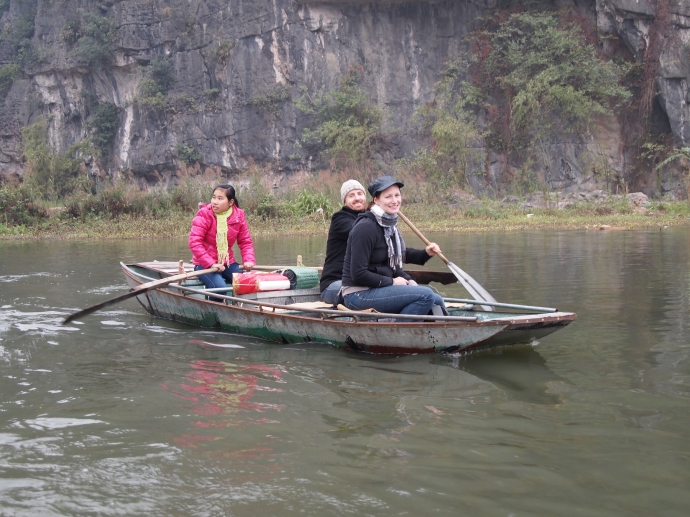

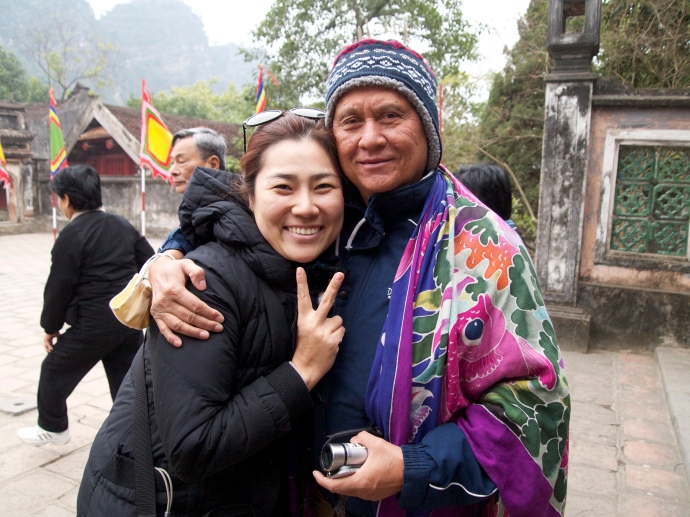


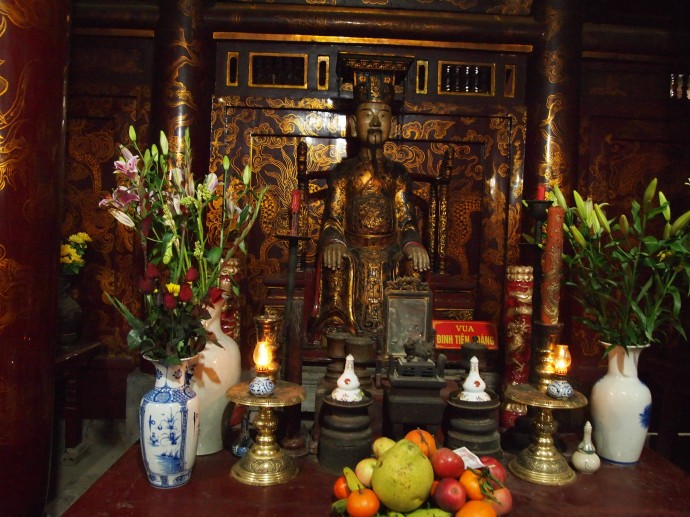

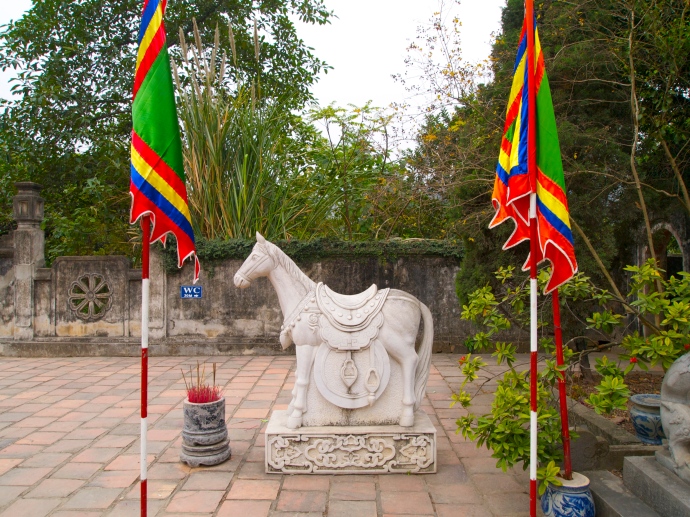
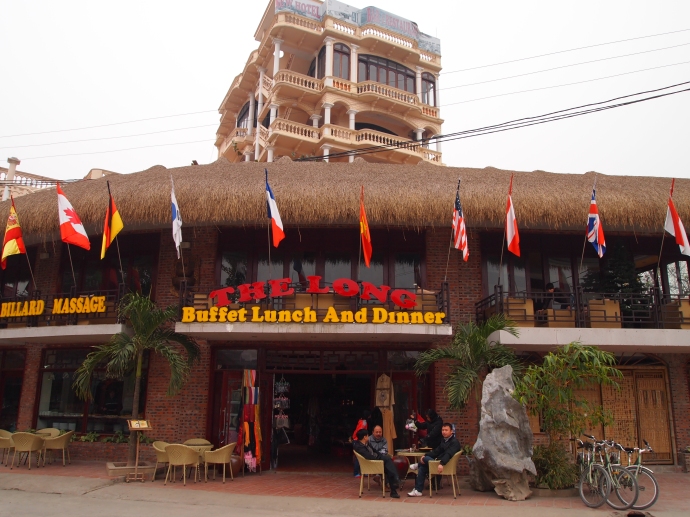
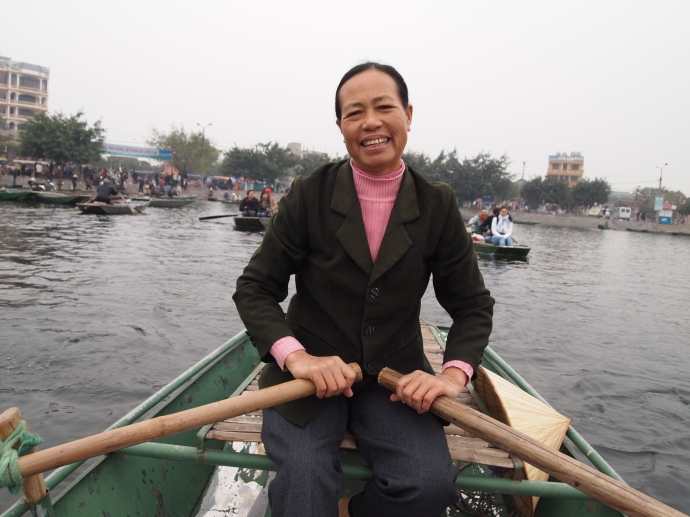

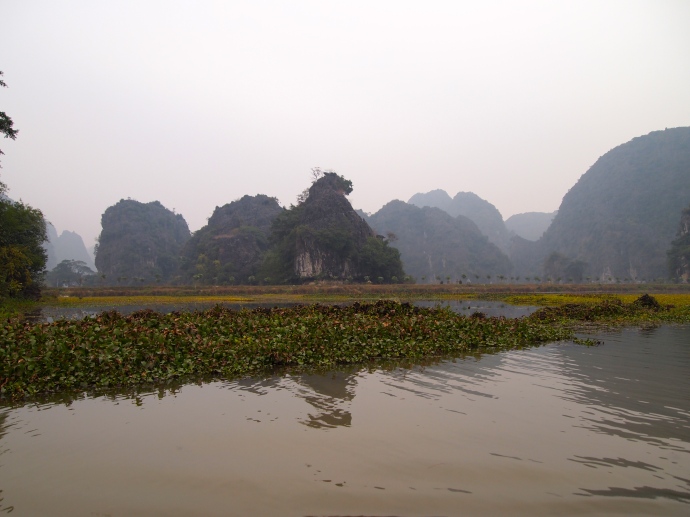
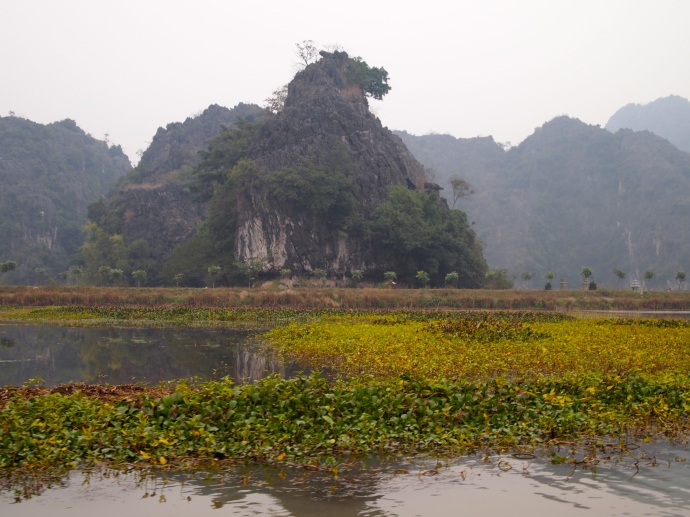


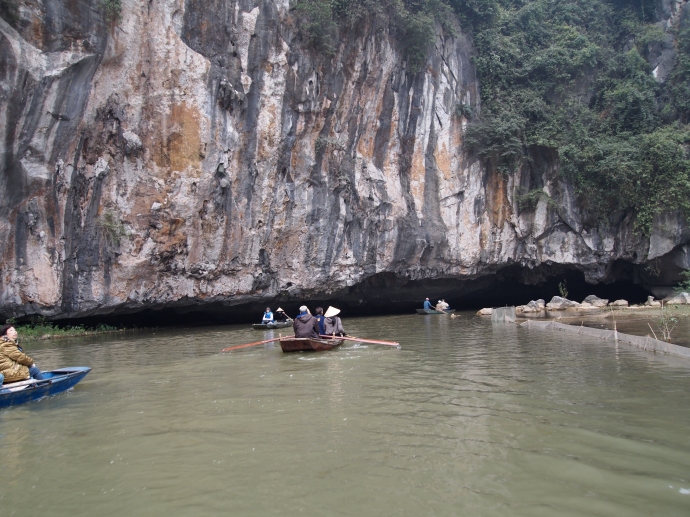

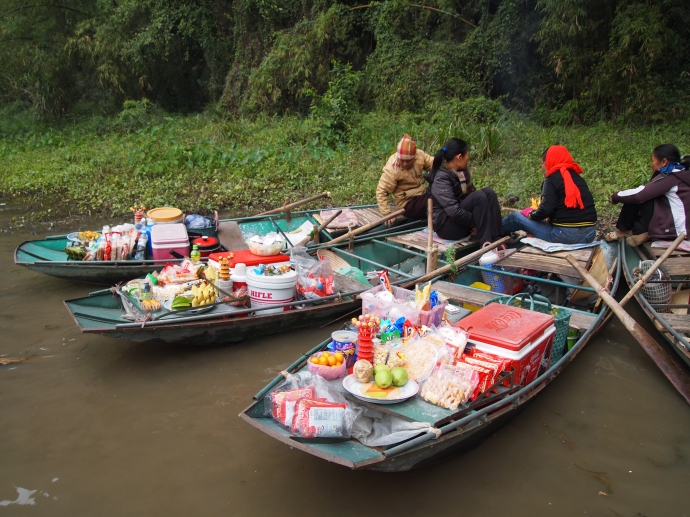
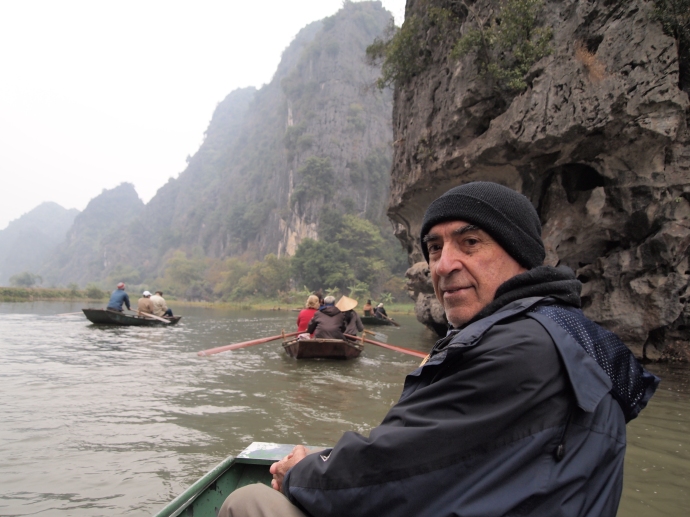
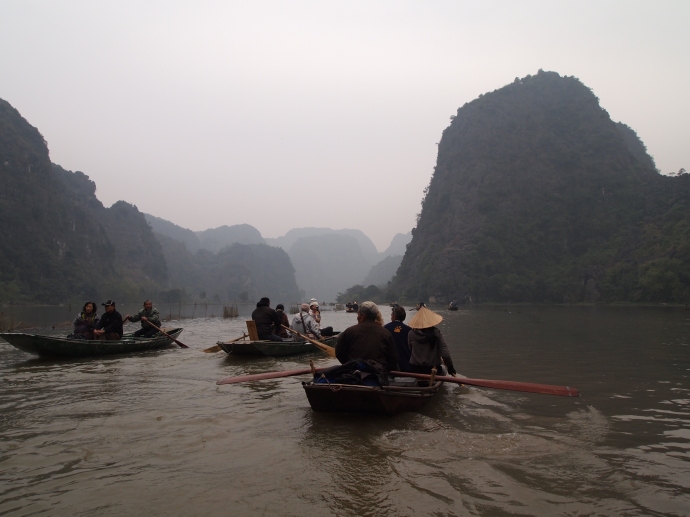


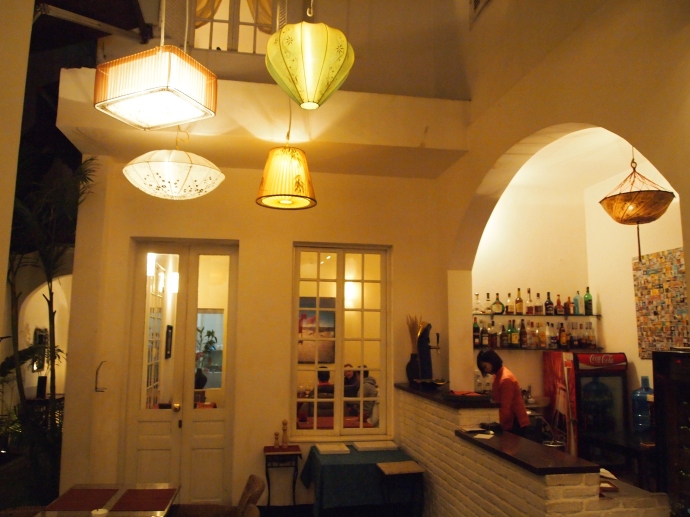
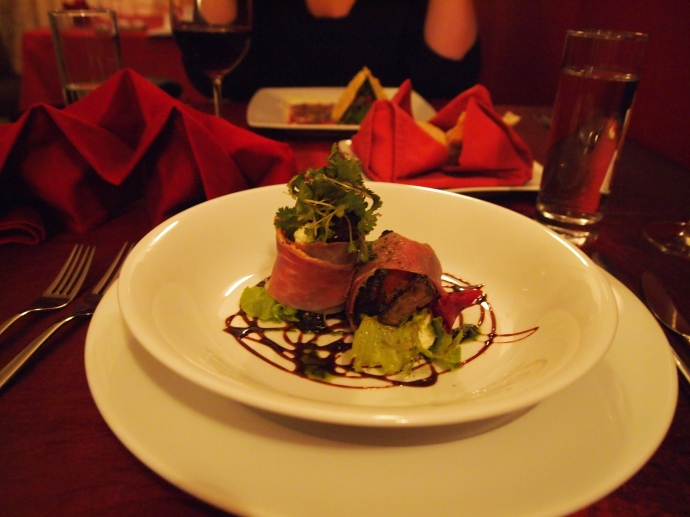





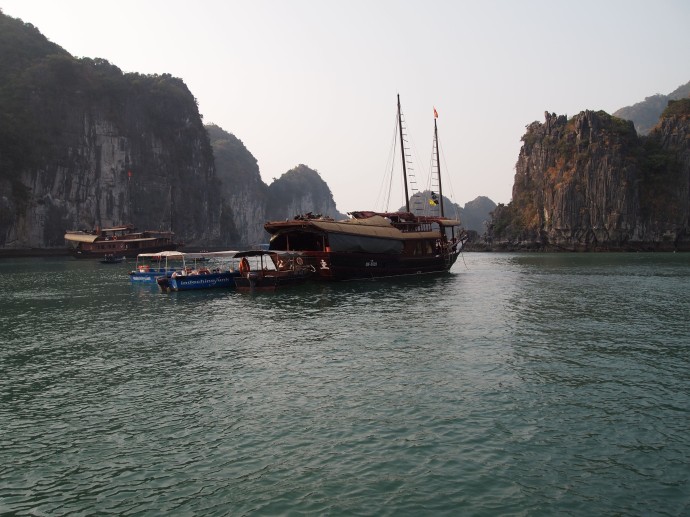



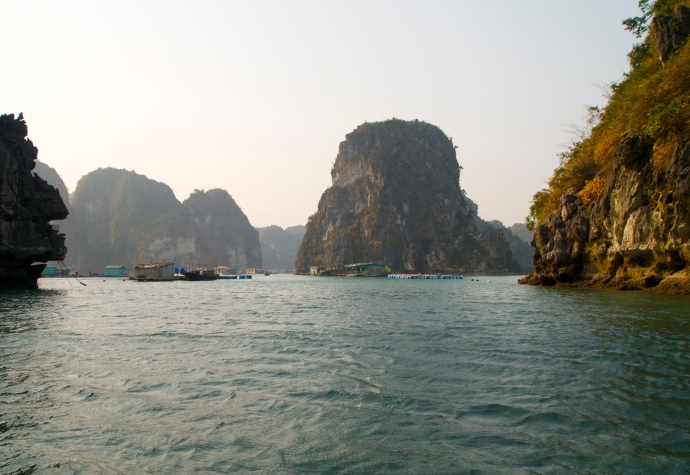
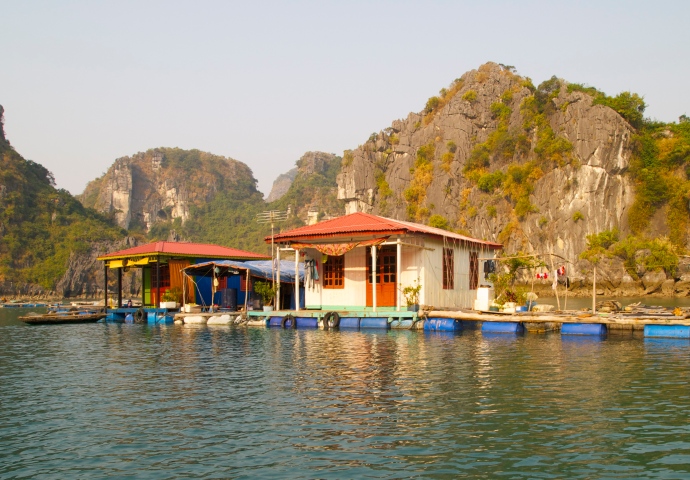
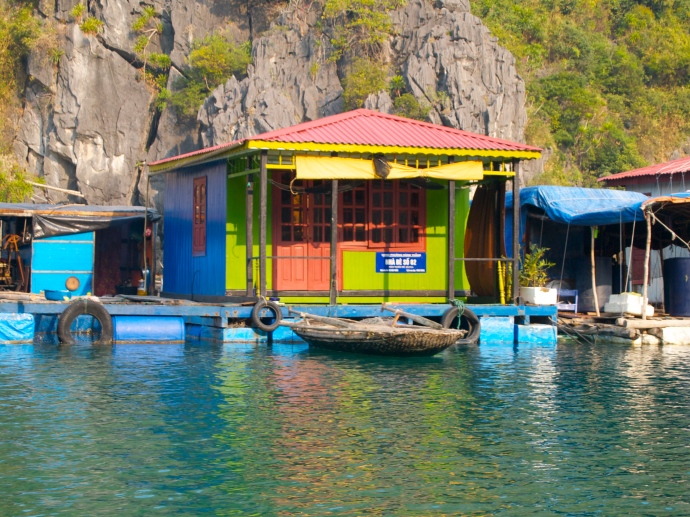



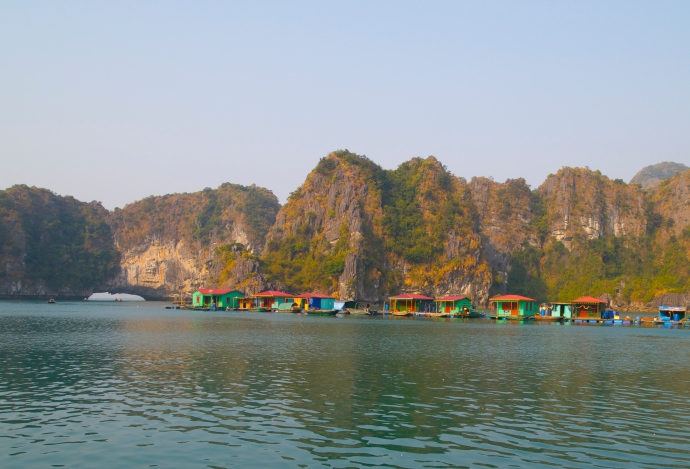
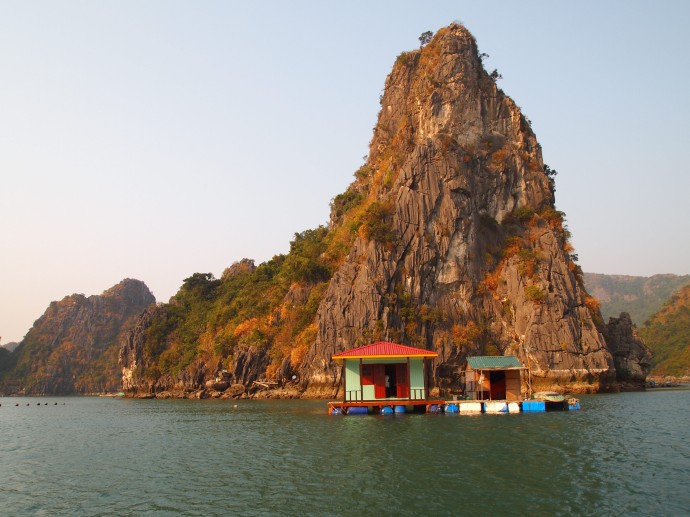
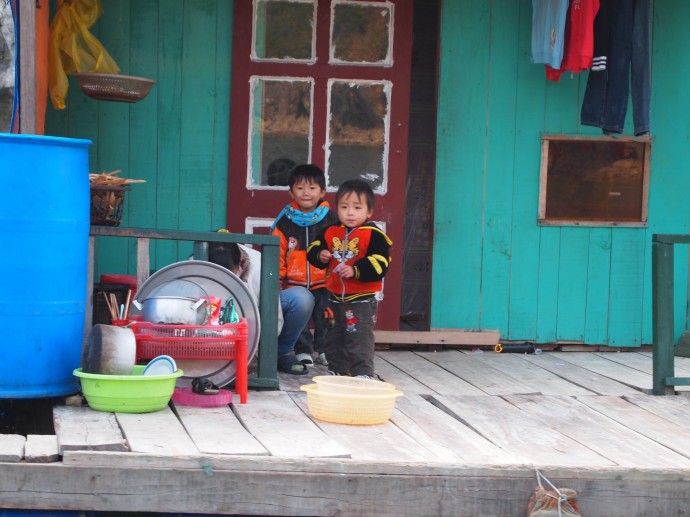
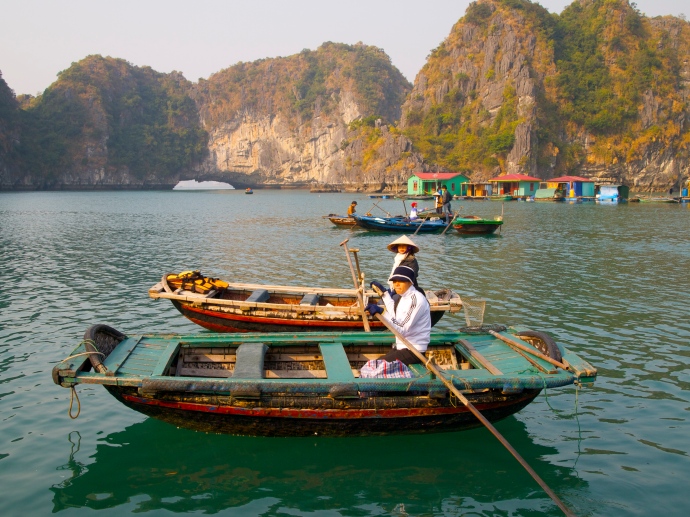
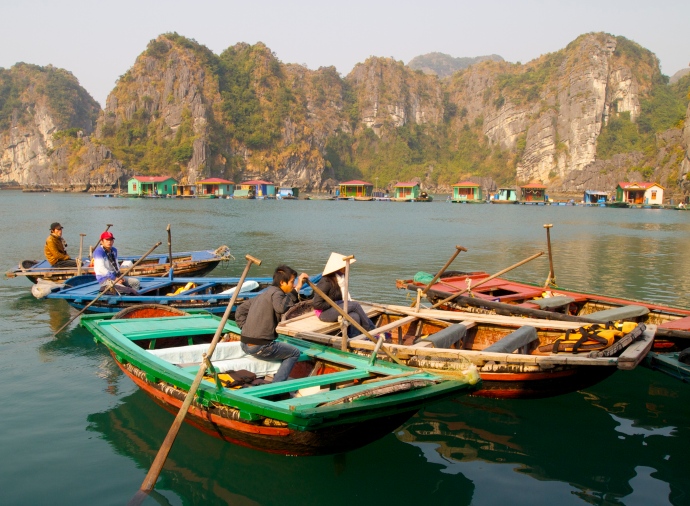
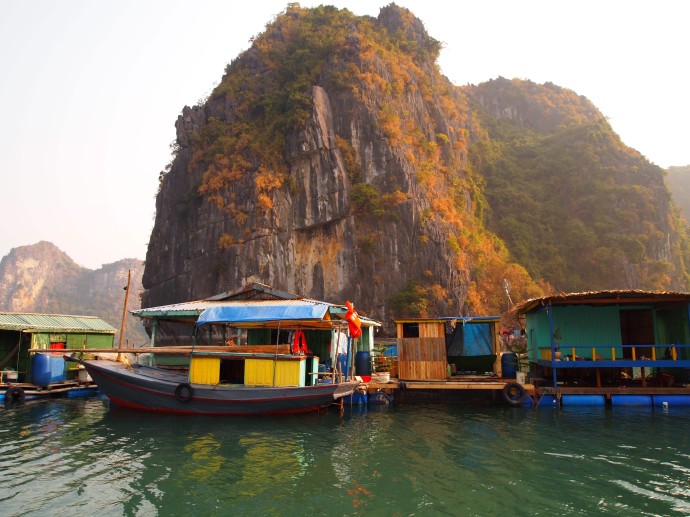
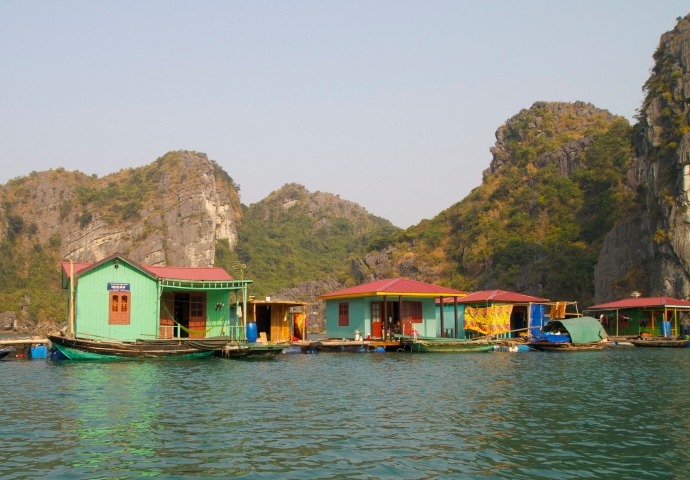


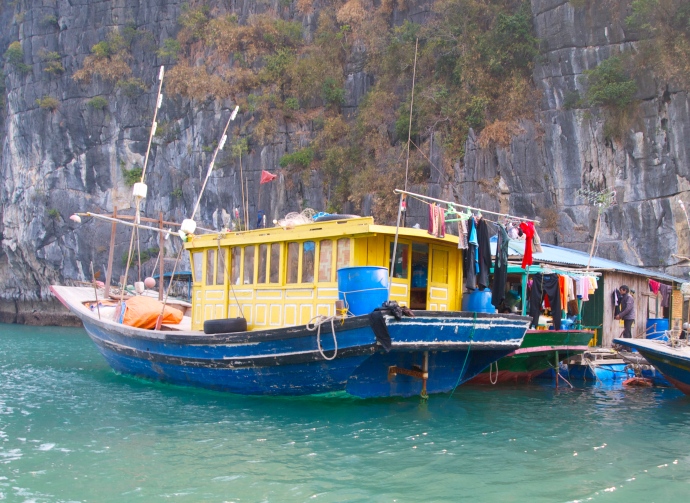
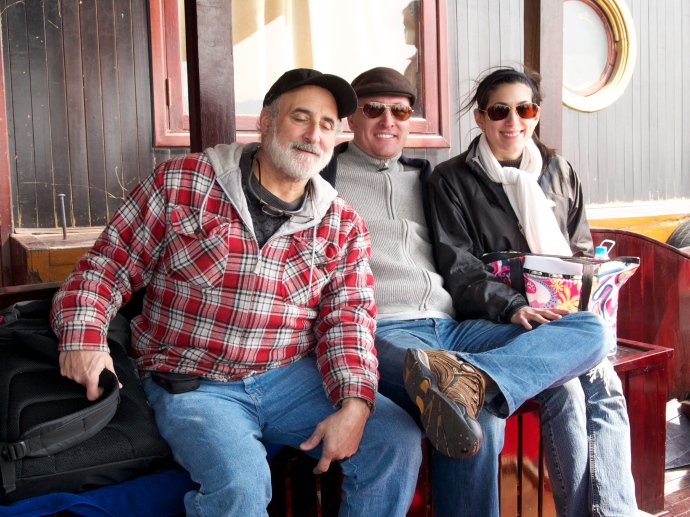

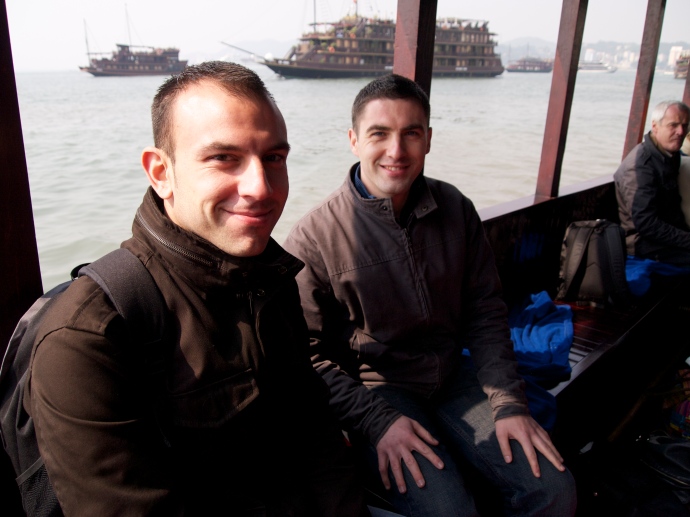
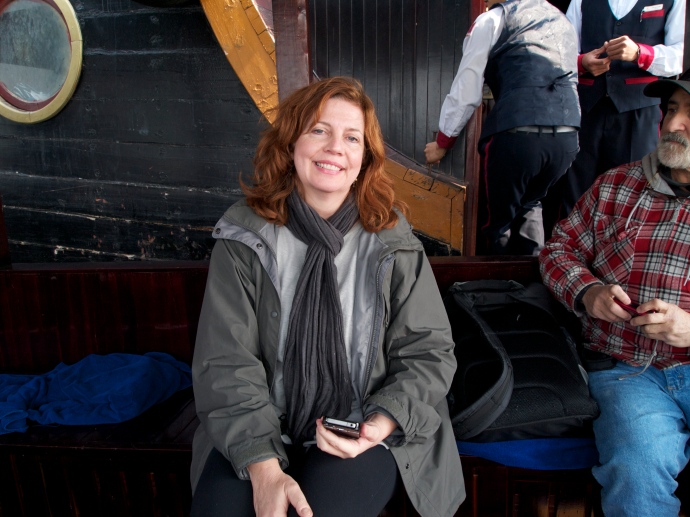

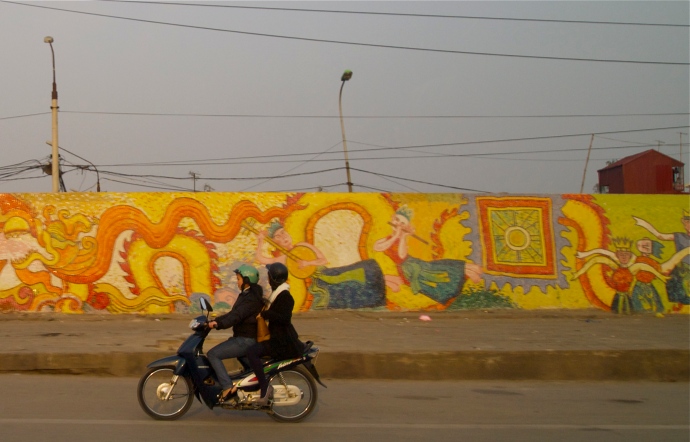

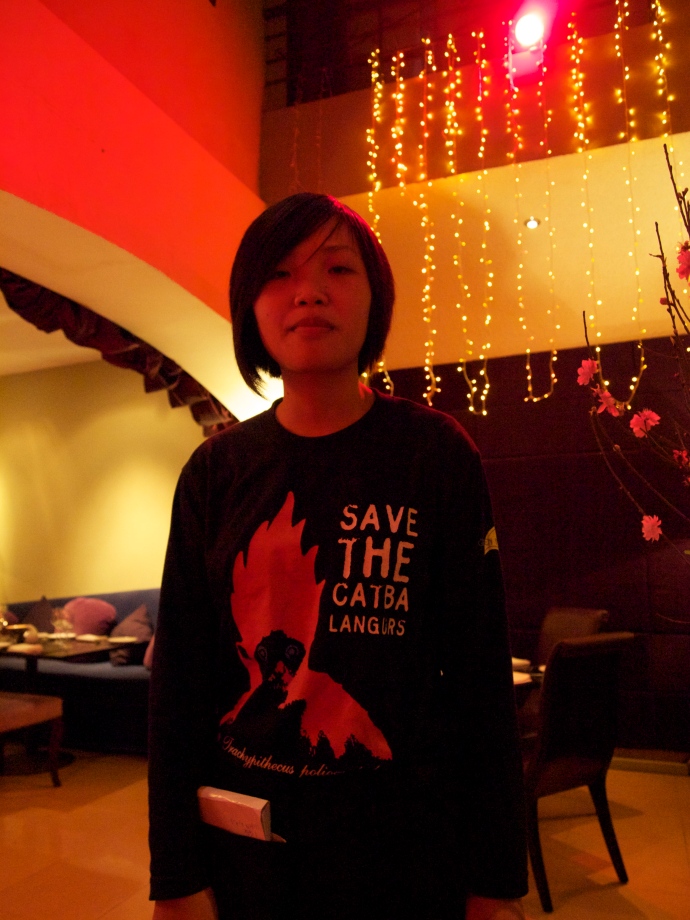
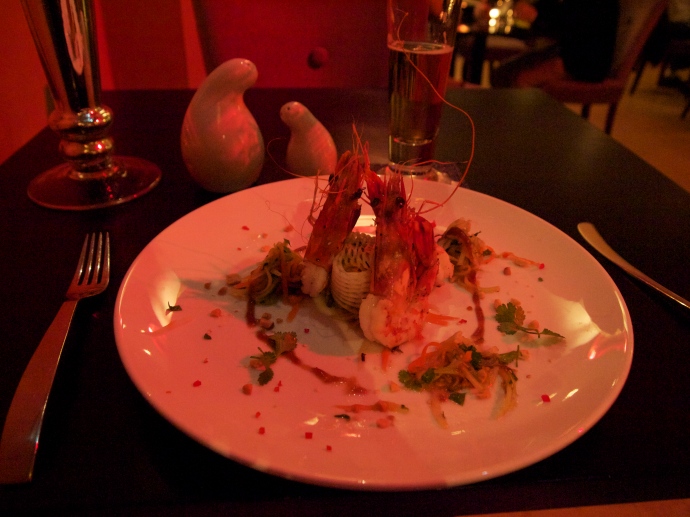
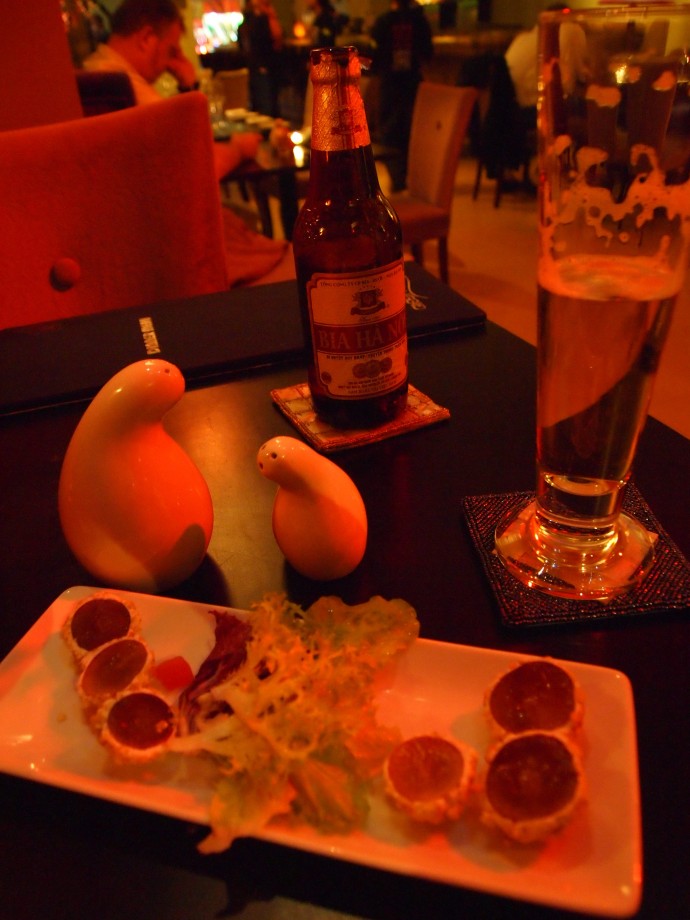


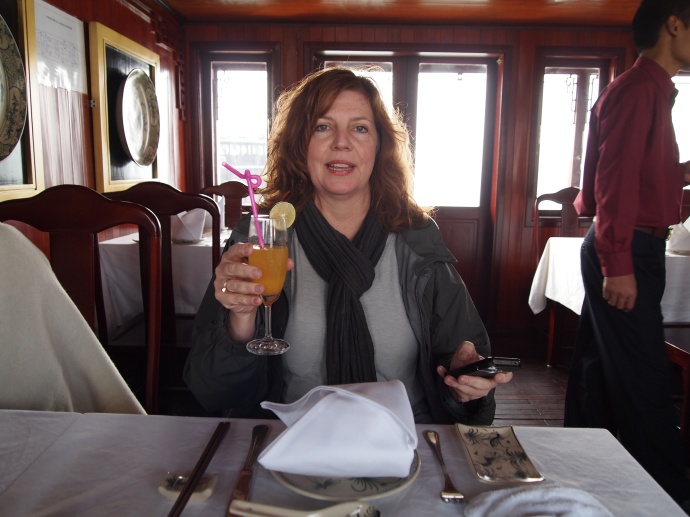
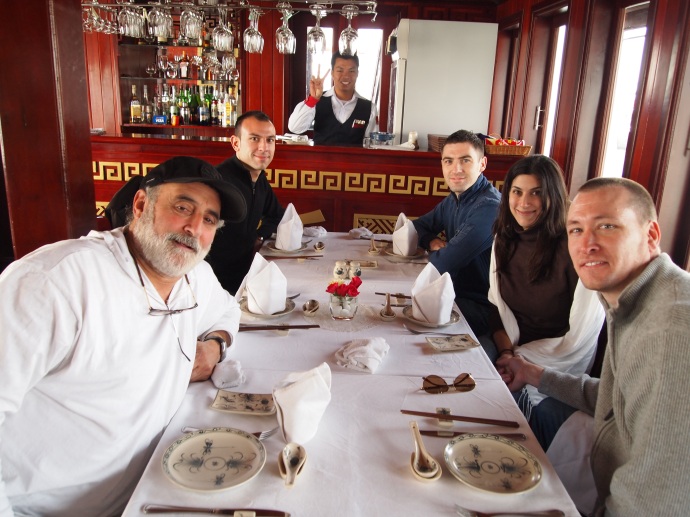
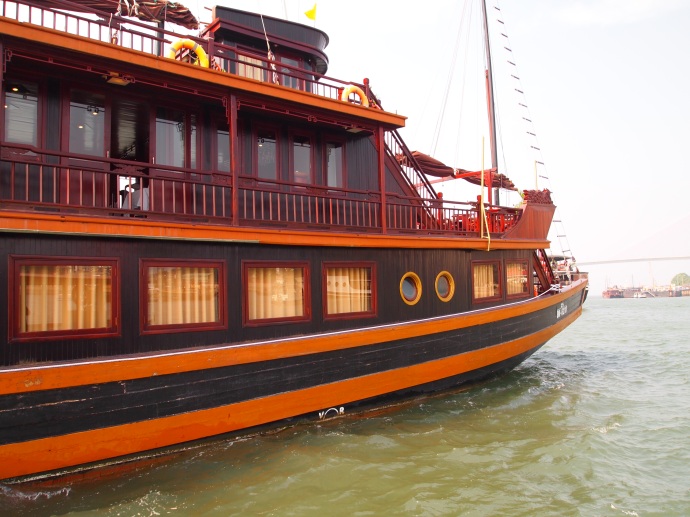
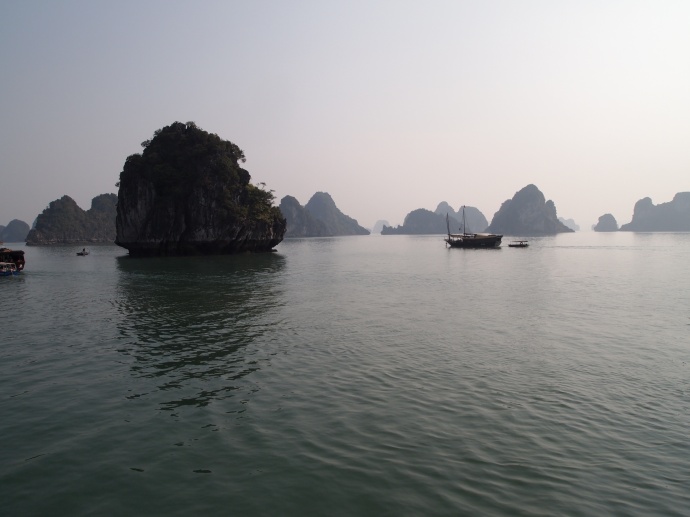

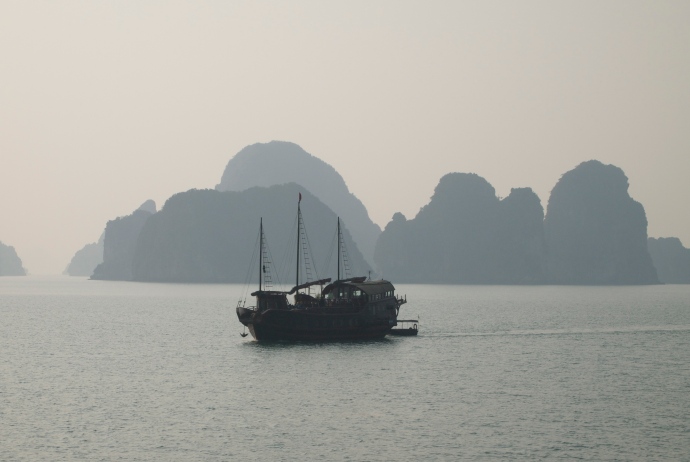



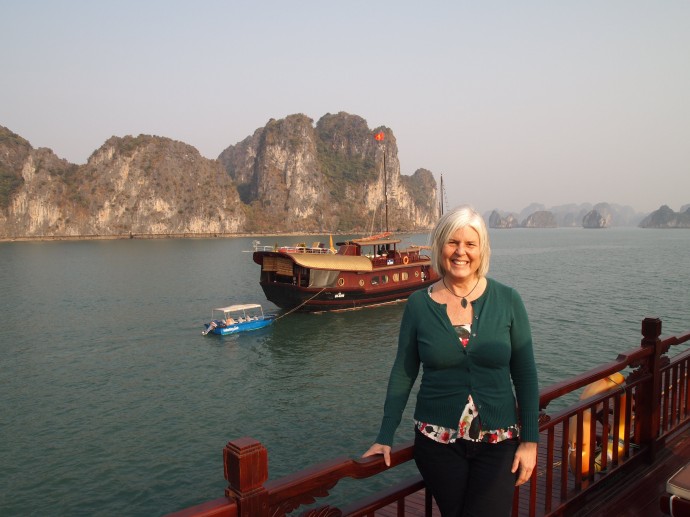

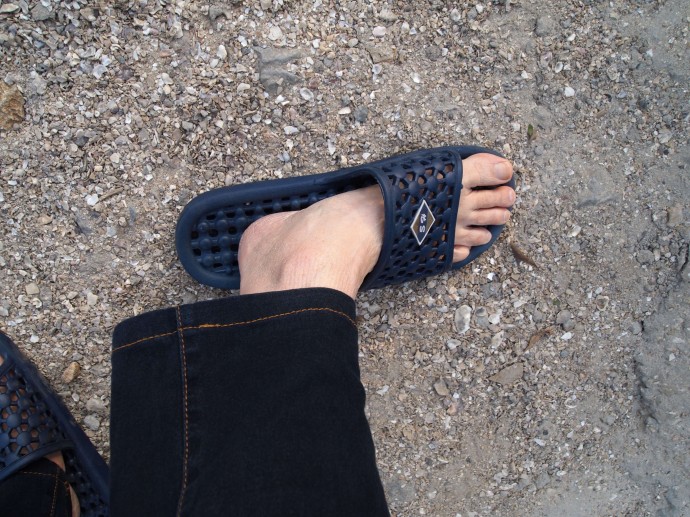

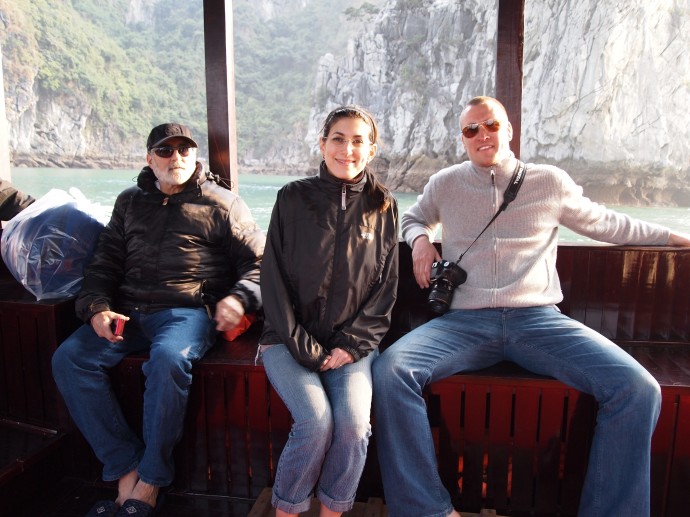

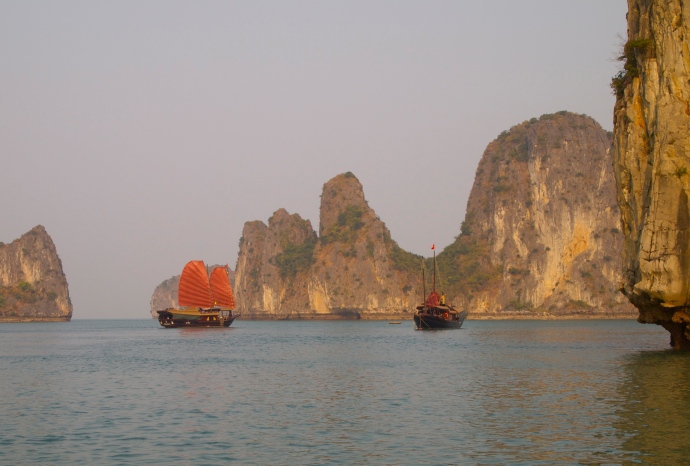
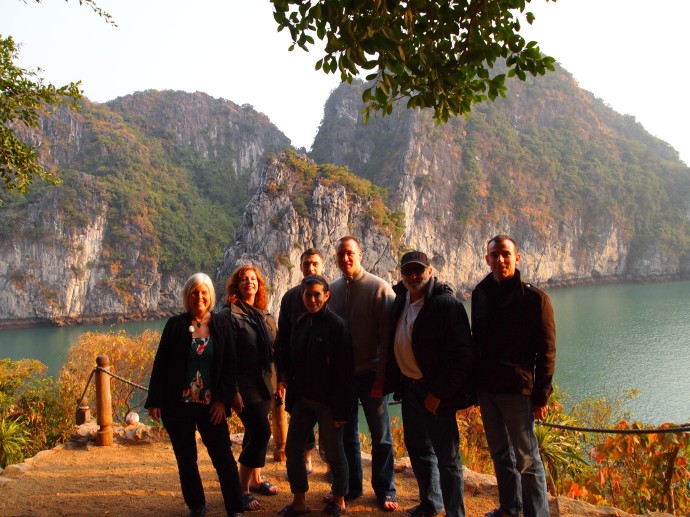
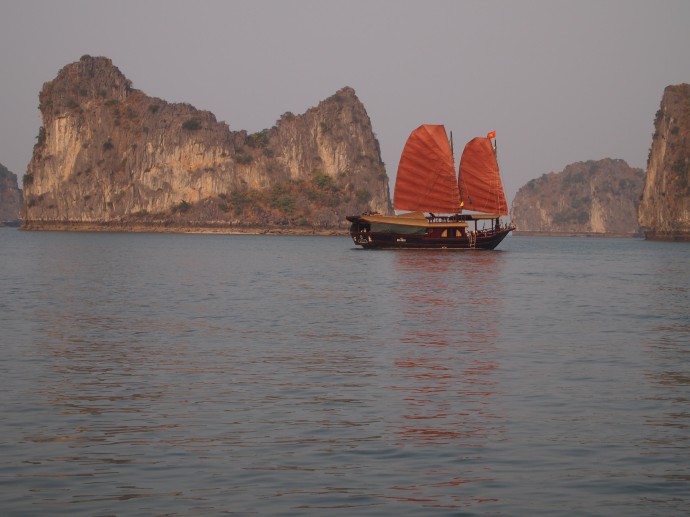
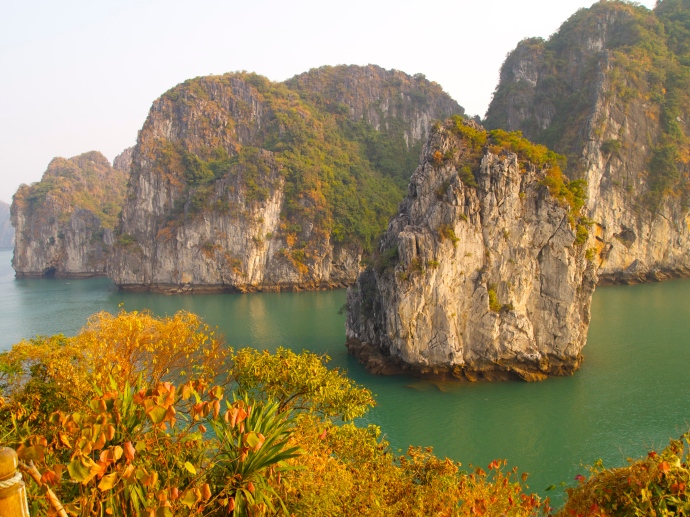
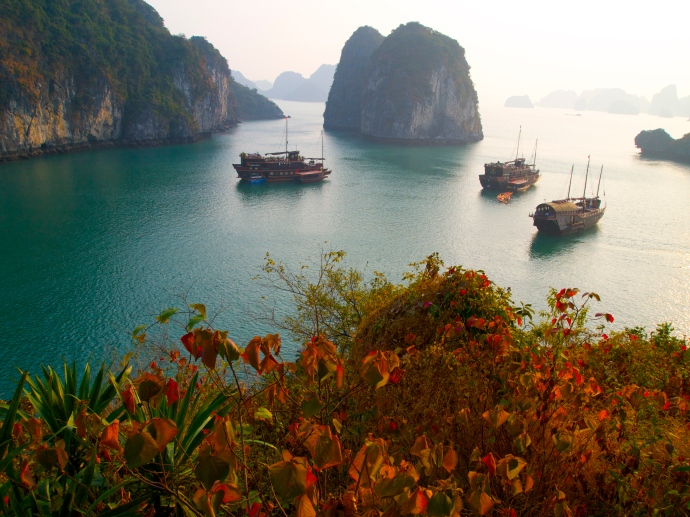
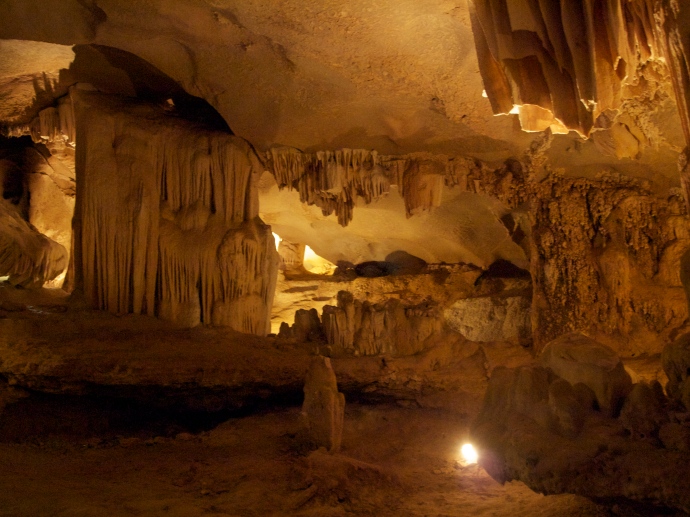
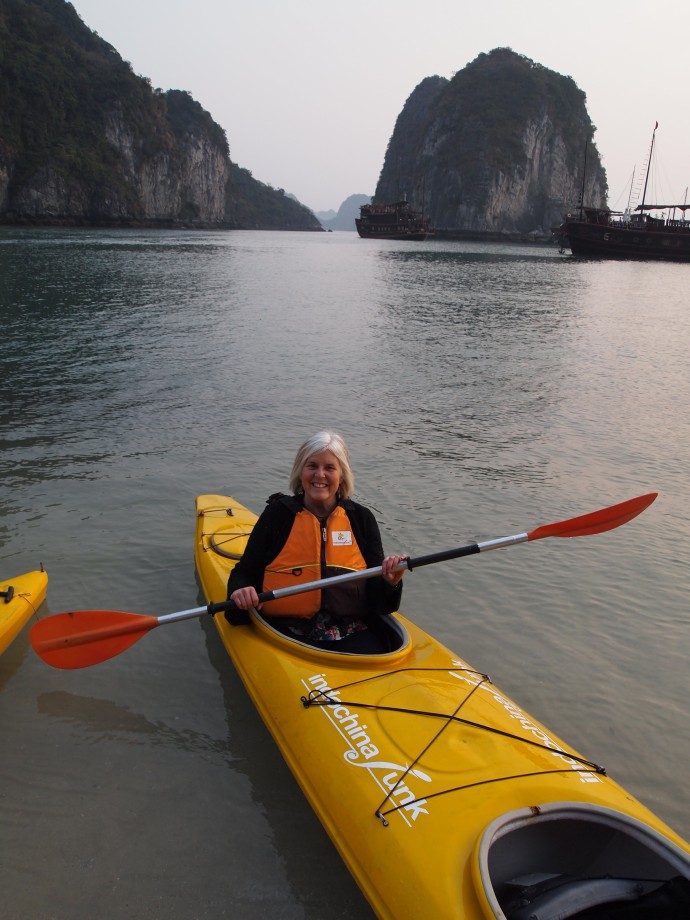
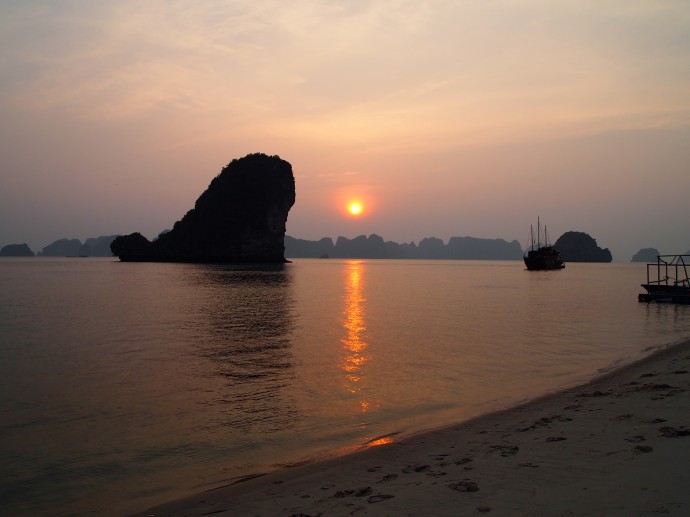
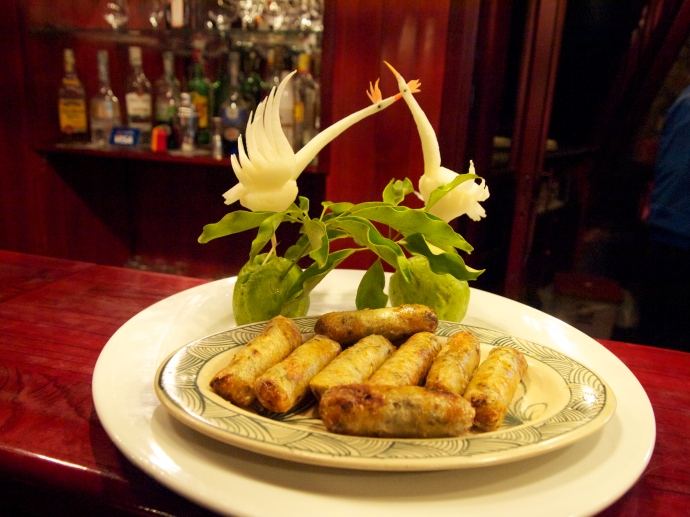





You must be logged in to post a comment.